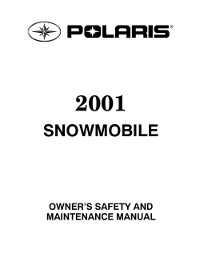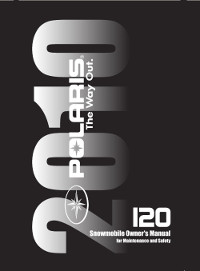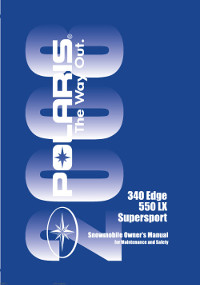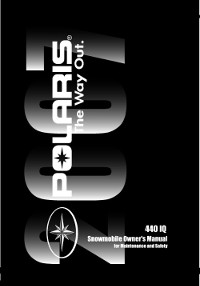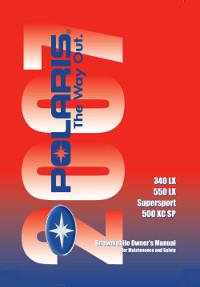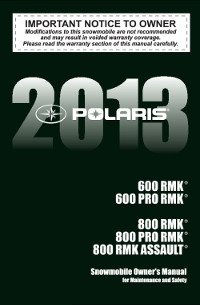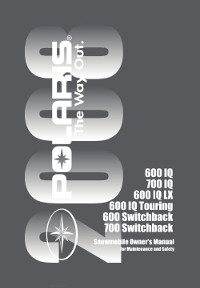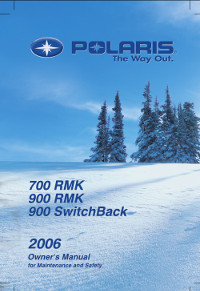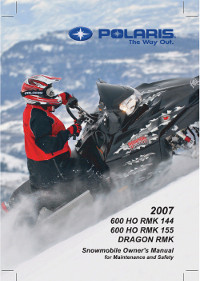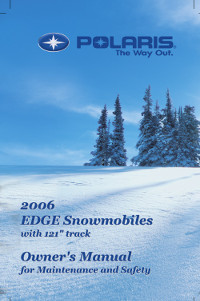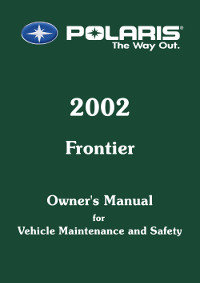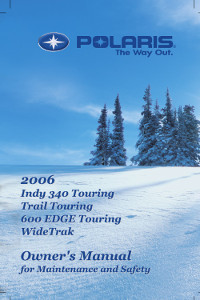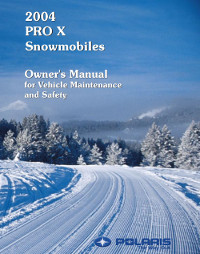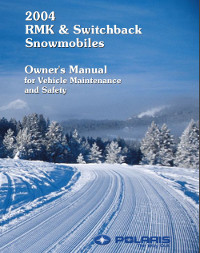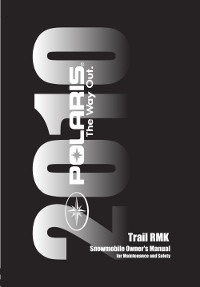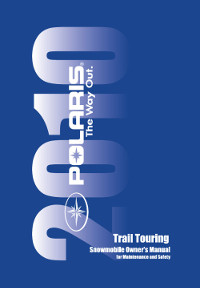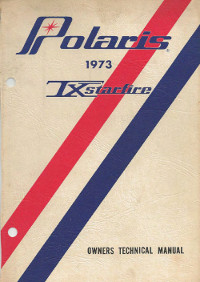- Manuals
- Brands
- Polaris Manuals
- Snowmobiles
- 650 2023
- Owner’s manual
-
Contents
-
Table of Contents
-
Troubleshooting
-
Bookmarks
Quick Links
2023
For Maintenance and Safety
OWNER’S
MANUAL
650, 850, PATRIOT 9R, & PATRIOT BOOST
PRO RMK & RMK KHAOS
MATRYX & MATRYX SLASH
Related Manuals for Polaris 650 2023
Summary of Contents for Polaris 650 2023
-
Page 1
2023 For Maintenance and Safety OWNER’S MANUAL 650, 850, PATRIOT 9R, & PATRIOT BOOST PRO RMK & RMK KHAOS MATRYX & MATRYX SLASH… -
Page 2
For more information go to www.P65Warnings.ca.gov/passenger-vehicle. For videos and more information about a safe riding experience with your Polaris vehicle, scan this QR Code® with your smartphone or visit: www.polaris.com/en-us/safety/… -
Page 3
2023 Owner’s Manual 650 Pro RMK 155 650 RMK Khaos 146 Slash 850 Pro RMK 155 850 Pro RMK 155 Slash 850 Pro RMK 163 Slash 850 Pro RMK 165 Slash 850 RMK Khaos 146 Slash 850 RMK Khaos 155 850 RMK Khaos 155 Slash 850 RMK Khaos 163 Slash 850 RMK Khaos 165 Slash… -
Page 4
Unless noted, trademarks are the property of Polaris Industries Inc. Allen® is a registered trademark of APEX BRANDS, INC. Loctite® is a registered trademark of Henkel Corporation. QR Code® is a registered trademark of DENSO WAVE INCORPORATED. BatteryMINDer® is a registered trademark of VDC Electronics Inc. -
Page 5
WELCOME Thank you for purchasing a POLARIS vehicle, and welcome to our world-wide family of POLARIS enthusiasts. Be sure to visit us online at www.polaris.com for the latest news, new product introductions, upcoming events, career opportunities and more. Here at POLARIS we proudly produce an exciting line of utility and recreational products. -
Page 6
SAFETY SYMBOLS AND SIGNAL WORDS The following signal words and symbols appear throughout this manual and on your vehicle. Your safety is involved when these words and symbols are used. Become familiar with their meanings before reading the manual. DANGER DANGER indicates a hazardous situation which, if not avoided, WILL result in death or serious injury. -
Page 7: Table Of Contents
TABLE OF CONTENTS Introduction ….7 Safety ….. . 13 Features .
-
Page 9: Introduction
PRESERVATION OF THE ENVIRONMENT POLARIS is committed to supporting an environmental education campaign. We encourage state and provincial governments across the snowbelt to adopt rigorous safety training programs that encourage protection of our environment, including wildlife and vegetation.
-
Page 10
POLARIS snowmobiles are engineered to conform to these SAE® standards. Our muffler systems are designed to reduce noise levels and must not be altered or removed. The sound of your snowmobile may not be welcome to non-snowmobilers, so you have a responsibility to operate your snowmobile with concern for others. -
Page 11
INTRODUCTION VEHICLE IDENTIFICATION NUMBERS Record your snowmobile’s identification numbers and key number in the spaces provided. NOTICE If installing an aftermarket tunnel wrap, do not cover the tunnel certification, tunnel VIN or emissions certification labels with the wrap. If the tunnel wrap doesn’t provide an opening for these labels, remove the section of wrap where the labels are located. -
Page 12
Remove the spare key and store it in a safe place. Your key can be duplicated only by mating a POLARIS key blank using the same identification number with one of your existing keys, so if both keys are lost, the ignition switch assembly must be replaced. -
Page 13
For applications that use vehicle-to-vehicle (V2V) communication, radio transmitter IC 5966A-RC7W has been approved by Innovation, Science and Economic Development Canada (ISED) to operate with Polaris antenna (part number 4019211) with gain of 3 dBi. Any antenna that has a gain greater than 3 dBi is prohibited for use with this device. -
Page 14
INTRODUCTION Hereby, Polaris Industries Inc. declares that the above radio equipment is in compliance with Directive 2014/53/EU. The full text of the EU declaration of conformity is available at the following internet address: https://www.polaris.com/en-us/radio-conformity/ REPORTING SAFETY DEFECTS (CANADA) To report a safety defect to Transport Canada, you may either fill out an online defect complaint form at their website (English: http://www/tc/gc/ca/recalls, French: http://www.tc.gc.ca/rappels) or contact their Defect Investigations and… -
Page 15: Safety
Always check major and vital safety components before every ride. All POLARIS snowmobiles are designed and tested to provide safe operation when used as directed. Failure of critical machine components may result from operation with any modifications, especially those that increase speed or power.
-
Page 16
SAFETY STAY CLEAR OF ENGINE Never attempt adjustments with the engine running. Turn off the ignition, open the side panels or hood, make the adjustment, secure shields and guards, secure the side panels and hood, and then restart the engine to check its operation. -
Page 17
HELMET Wearing a helmet can prevent a severe head injury. Whenever riding this POLARIS vehicle, always wear a helmet that meets or exceeds established safety standards. Clasp the buckle and pull each strap tight to ensure the helmet is properly secured to the head. -
Page 18
SAFETY CLOTHING WARNING Avoid wearing loose clothing or long scarves, which can become entangled in moving parts and cause serious injury. Always wear an approved helmet and eye protection. Be prepared, be warm and be comfortable when riding. Be aware of the weather forecast, especially the windchill, and dress accordingly. -
Page 19
SAFETY EXCESSIVE SPEED WARNING High speed driving, especially at night, could result in serious injury or death. Always reduce speed when driving at night or in inclement weather. Always observe all state and local laws governing snowmobile operation and speed limits. Always be alert and pay attention to the trail ahead. If your speed is 40 MPH (64 km/h), your snowmobile is traveling about 60 feet (18 m) per second. -
Page 20
SAFETY DISABLED OPERATORS Safe operation of this rider-active vehicle requires good judgement and physical skills. Operators with cognitive or physical disabilities have an increased risk of loss of control, which could result in serious injury or death. MOUNTAINOUS TERRAIN RIDING Mountainous terrain operation, even for experienced riders, can present conditions and situations that could result in serious injury or death. -
Page 21
SAFETY GET THE SAFETY GEAR In addition to carrying a spare belt, spark plugs and tools on each snowmobile, each person in your riding group should wear the recommended snowmobile riding apparel and carry (on their person) the following survival items when riding in mountainous terrain: •… -
Page 22
SAFETY GET TO KNOW YOUR SAFETY GEAR Following the safety gear and apparel recommendations will increase your chances of survival if you encounter an avalanche or become stranded in the backcountry, but even experienced and properly-equipped snowmobilers, hikers and skiers perish in avalanches or succumb to hypothermia. Using a beacon or probe for the first time during an avalanche recovery operation, or not knowing how to deploy your avalanche air bag backpack during a slide, should be considered UNACCEPTABLE to you and all members of your riding group. -
Page 23
SAFETY GET THE PICTURE Slopes steeper than 30º are more prone to avalanches, but any slope should be considered avalanche terrain, even small slopes with trees. Low-angle slopes are also avalanche terrain if they have steeper slopes above them. NOTICE The 30º… -
Page 24
The track features paddles that pack and shovel snow rather than dig in and grip the snowpack. Because POLARIS mountain snowmobiles feature tall track paddles, the rear suspension rails and sliders will sit above the snowpack on a groomed trail. -
Page 25
• www.lavinprognoser.se for Swedish riders. • www.avalanches.org for European riders. GET AVALANCHE SAFETY TRAINING POLARIS recommends you and all members of your riding group participate in an avalanche safety course. Visit the education section of the Avalanche website for your region. -
Page 26
SAFETY North American Public Avalanche Danger Scale Avalanche danger is determined by the likelihood, size and distribution of avalanches. DANGER LEVEL TRAVEL ADVICE LIKELIHOOD AVALANCHE SIZE AND AVALANCHES DISTRIBUTION Natural and Large to very Avoid all avalanche human-triggered large avalanches Extreme terrain. -
Page 27
SAFETY ICE AND SNOW BUILD-UP WARNING Ice and snow build-up may interfere with the steering of your snowmobile, resulting in serious injury or death. Keep the under-hood area free of snow and ice. Before driving, manually turn the skis to the left and right to be sure ice and snow are not interfering with full left and right steering. -
Page 28
SAFETY OPERATING IN DEEP SNOW If the snowmobile becomes stuck in snow, clear the running board area of snow, then step down the snow in front of the snowmobile so that when the throttle is opened, the snowmobile will be able to climb up and over the snow. DRIVING DOWNHILL When riding downhill, shift your weight to the rear of the snowmobile and reduce your speed to a minimum. -
Page 29
SAFETY DRIVE BELT Do not operate the engine with the drive belt removed. Any servicing that requires operation without a belt can be performed by your dealer. WARNING Operation of the engine with the belt removed may result in injury or damage to the engine. -
Page 30
SAFETY DRIVING RESPONSIBLY Every snowmobile handles differently, and even the most docile conditions may become dangerous if operators drive improperly. If you’re new to snowmobiling, acquaint yourself with the snowmobile and with what it will and won’t do under various conditions. Even seasoned drivers should spend some time getting the feel for a snowmobile before attempting ambitious maneuvers. -
Page 31
SAFETY WINDCHILL/TEMPERATURE CHARTS The following information is provided to help you determine when temperatures become dangerous for riding. WINDCHILL CHART (°F) Wind Actual Thermometer Reading (°F) Speed -10 -15 -20 -25 -30 -35 -40 -45 in MPH Equivalent Temperature (°F) Calm -10 -15 -20 -25 -30 -35 -40 -45 -11 -16 -22 -28 -34 -40 -46 -52… -
Page 32
If any label becomes illegible or comes off, contact your POLARIS dealer for a replacement. Replacement safety labels are provided by POLARIS at no charge. The part number is printed on the label. -
Page 33
SAFETY CLUTCH WARNING WARNING Belt Removal – All Units 1. For electric reverse models, engine must be stopped in forward to allow clutch opening. 2. Install L-wrench from fender into the open threaded hole in the driven clutch. 3. Turn the L-wrench clockwise to open the sheaves and replace the belt. Return the L-wrench to the fender. -
Page 34
SAFETY MOVING PARTS WARNING WARNING • Read owner’s manual. • Moving parts can crush and cut. • Keep hands clear. • Do not operate with guards or side panels removed. Part Number: 7300297. FUEL TRANSPORT WARNING WARNING NEVER carry fuel or other flammable liquids on this vehicle Failure to follow this instruction could lead to serious burn injuries or death. -
Page 35: Features
FEATURES FEATURES COMPONENT LOCATIONS NOTICE The figures below are for reference only. Your model may differ slightly. Skis Handlebar Upper Control Arm Independent Front Tether and Key Lower Control Arm Suspension (IFS) Switch Rail Scratcher Nosepan Fuel Cap Rear Track Shock Front Bumper Operator Seat Rail…
-
Page 36
FEATURES PATRIOT BOOST SYSTEM COMPONENTS (IF EQUIPPED) Intake Boost Tube Exhaust Bypass Tube Turbo Intake Tube Lower Bypass V-Band Clamp Smart Boost Wastegate Actuator Exhaust Silencer Upper Bypass V-Band Clamp Turbo V-Band Clamp Exhaust Tune Pipe/Heat Shields Turbocharger… -
Page 37
FEATURES IGNITION SWITCH The ignition switch has three positions: OFF, RUN, and START. OFF Vehicle / Display power off RUN Vehicle / Display power on START Activates starter motor (if equipped) If equipped with electric start, turn the key to START to crank the engine. -
Page 38
FEATURES ADJUSTABLE HEADLIGHT NOTICE The image below is for reference only. Your model may differ slightly. HEADLIGHT INSPECTION It is very crucial to correctly complete the steps below in order to achieve optimal headlight performance. The headlight can be inspected for vertical aim using the following procedure. -
Page 39
FEATURES HEADLIGHT ADJUSTMENT 1. Shut off engine. WARNING To prevent serious injury, NEVER attempt to adjust the headlight while the engine is running. 2. If adjustment is necessary, an adjuster knob is located on the back of the headlight, which can be accessed by removing the vehicle’s left side panel. NOTICE The adjuster knob is located at the rear of the light above the plug. -
Page 40
Inspect and change the belt at the intervals outlined in the Maintenance chapter. Special tools are required to remove and install the QUICKDRIVE belt. Your POLARIS dealer can assist with this service. BELT HANDLING • Store a new belt in original packaging. Remove only when ready for installation. -
Page 41
The rail scratchers must be removed as they interfere with the accessory bogie wheels. ACCESSORIES POLARIS offers a wide range of accessories for your snowmobile to help make each ride more enjoyable. Use only POLARIS parts and accessories on your POLARIS snowmobile. Use of unapproved parts and accessories may result in: •… -
Page 42
FEATURES DETONATION ELIMINATION TECHNOLOGY (DET) When DET senses and takes action to reduce detonation, the driver may notice a drop in engine RPM and/or reduced performance. The ECU will illuminate the check engine LED and display “DETONATION” on the LCD screen whenever the DET system is active. If the ECU determines the detonation cannot be controlled by normal means, and further operation may cause engine damage, the check engine LED will flash, the instrument clusters will display “DETONATION”… -
Page 43
FEATURES NOTICE The instrument cluster alert indicates which cylinder is experiencing detonation. -
Page 44
SECURITY SYSTEM (IGNITION LOCK SYSTEM) Your snowmobile has an optional security function that can be activated by an authorized Polaris dealer. If you have this feature activated, you can lock the ignition to prevent unauthorized use when leaving the snowmobile unattended. -
Page 45: Gauge
GAUGE GAUGE STANDARD INSTRUMENT CLUSTER Check Engine Playback Reverse Engine Hot Low Fuel Security Low Oil High Beam MODE Button Low Battery Voltage Parking Brake SET Button NOTICE Certain products will damage the lens and other plastic surfaces. Do not use alcohol to clean the instrument cluster.
-
Page 46
GAUGE INDICATOR LAMPS INDICATOR CONDITION This indicator appears if an EFI-related fault occurs. Do not operate the snowmobile if this warning appears. Serious engine damage could result. Your dealer can assist. The over-temperature indicator will illuminate when the engine is overheating. -
Page 47
GAUGE RIDER INFORMATION CENTER The rider information center is located in the instrument cluster. The center displays vehicle speed, engine speed, odometer, trip meters (2), total engine hours of operation, fuel level, engine temperature, and a diagnostic display mode. Setting changes must be made with the engine running or with the vehicle powered by an external DC power supply connector. -
Page 48
GAUGE INFORMATION DISPLAY AREA This area displays either engine speed or vehicle speed (whichever is not displayed in the speed display), engine temperature, maximum vehicle speed, and speed or RPM. To change the display, press and release the MODE button or the MODE switch until the desired item is displayed. -
Page 49
GAUGE ODOMETER/ENGINE HOUR DISPLAY AREA This area displays the odometer, Trip 1 meter, Trip 2 meter, CLOCK, and Engine Hours meter. The odometer displays the total distance traveled by the vehicle since manufacture. Each trip meter records the distance traveled by the vehicle on a trip if the meter is reset before each trip. -
Page 50
GAUGE 3. Press and release the SET button. RECORD will appear in the information display area. 4. To begin recording, Press and release the SET button. The playback indicator will flash while recording is in progress. Recording is complete when the light stops flashing. NOTICE To stop recording at any time during the recording process, press and release the SET button. -
Page 51
GAUGE 4. Press and release the SET button twice. PLAY will appear in the information display area. 5. Press and release the SET button to play the recorded data. Once playback has concluded, REPLAY will appear in the information display area. 6. -
Page 52
SECURITY SYSTEM (IGNITION LOCK SYSTEM) This system is an optional feature and will not function until it has been activated by your authorized POLARIS dealer. If you have this feature activated, you can lock the ignition to prevent unauthorized use when leaving the snowmobile unattended. -
Page 53
GAUGE 1. Press and hold the center button on the instrument cluster to enter the Options Menu. 2. Press and release the MODE button until SECURITY OFF appears in the information display area. 3. Press and release the SET button. ENTER CODE will appear in the information display area. -
Page 54
GAUGE 7. Press and hold the SET button to accept the 2nd digit and advance to the 3rd digit. 8. Press and hold the SET button to accept the 3rd digit and submit code. If code is correct, SECURITY ON will appear in the information display area. The system is now locked. -
Page 55
GAUGE TASK 3: Unlock the System NOTICE To unlock the system for the first time, use code 000. 1. While the engine is running, Press and release the SET button. ENTER CO will appear in the information display area. 2. Press and release the SET button to increase the 1st digit. 3. -
Page 56
GAUGE 5. Press and hold the SET button to accept the 2nd digit and advance to the 3rd digit. 6. Press and release the SET button to increase the 3rd digit. 7. Press and hold the SET button to accept the 3rd digit and submit code. If code is correct, SECURITY OFF will appear in the information display area NOTICE The system is now unlocked. -
Page 57
GAUGE TASK 4: Enter Your New Security Code 1. Immediately after locking and unlocking the system, and while SECURE OFF is displayed, simultaneously press and hold the MODE and SET buttons. SET NEW CODE will appear on the information display area. 2. -
Page 58
GAUGE 6. Press and release the SET button to increase the 3rd digit. 7. Press and hold the SET button to accept the 3rd digit. CODE SET will appear in the information display area, and then the new code will blink three times in the information display area NOTICE Your new code is now set. -
Page 59
GAUGE LOCKING SYSTEM WITH PERSONAL SECURITY CODE 1. Start the engine. 2. Press and hold the center button on the instrument cluster to enter the Options Menu. 3. Press and release the MODE button until SECURITY OFF appears in the information display area. -
Page 60
GAUGE 7. Press and release the SET button to increase the 2nd digit. 8. Press and hold the SET button to accept the 2nd digit and advance to the 3rd digit. 9. Press and hold the SET button to accept the 3rd digit and submit code. If code is correct, SECURITY ON will appear in the information display area. -
Page 61
GAUGE UNLOCKING SYSTEM WITH PERSONAL SECURITY CODE 1. While the engine is running, Press and release the SET button. ENTER CODE will appear in the information display area. 2. Press and release the SET button to increase the 1st digit. 3. -
Page 62
GAUGE 6. Press and release the SET button to increase the 3rd digit. 7. Press and hold the SET button to accept the 3rd digit and submit code. If code is correct, SECURITY OFF will appear in the information display area NOTICE The system is now unlocked. -
Page 63
The codes will become inactive codes if power is interrupted. Inactive codes are stored in the history of the unit. Please see your POLARIS dealer can help retrieve inactive codes. -
Page 64
GAUGE 1. Do not stop the engine. 2. Press and hold the center button on the instrument cluster to enter the Options Menu. 3. Press and release the MODE button until DIAGCODE appears in the information display area. The Diagnostic display mode will appear in the Options Menu if there is an active trouble code. -
Page 65
GAUGE 1. Start the engine. 2. Press and hold the center button to enter the Options Menu. 3. Press and release the MODE button until FUEL TYPE is displayed in the information display area. 4. Press and release the SET button to toggle through available options until the desired fuel type is displayed in the information display area. -
Page 66
GAUGE FLASHING INDICATOR Flashing indicators indicate continued operation could result in serious engine damage. The engine management system will automatically reduce engine power and create a misfire condition. Stop the engine immediately. Allow the engine to cool down. NOTICE If engine overheating seems to be caused by something other than poor cooling conditions, your dealer or other qualified technician can perform a diagnosis. -
Page 67: Ride Command Display
RIDE COMMAND DISPLAY RIDE COMMAND DISPLAY OVERVIEW Welcome to Polaris Ride Command. This intuitive software includes a variety of interactive features and access to your snowmobile’s custom information. For a safe and enjoyable riding experience with your new display, be sure to read your vehicle’s owner’s manual and this user’s guide.
-
Page 68
RIDE COMMAND DISPLAY SPEED LIMITATION Various aspects of the display such as the front and rear cameras, phone contacts, and call logs may be unavailable while driving at high speeds. DEVICE OPERATING REQUIREMENTS Phone functionality, in pairing with this display, is dependent on the capabilities of your cell phone. -
Page 69
RIDE COMMAND DISPLAY BUTTON DESCRIPTION FUNCTION Opens and closes the Badge Panel. Polaris Button Zooms out when using the map and Down Button scrolls down through lists of features. Cycles all screens and backs user Back Button out of menus. -
Page 70
RIDE COMMAND DISPLAY CONFIGURE GAUGE SCREEN The display allows up to four customized gauge screens. All but one screen can be deleted; one will always remain as the default. NOTICE In the gauge configuration panel, display buttons and hand controls will not work. -
Page 71
RIDE COMMAND DISPLAY 4. Select the Data tab As the widget slots on the left are selected, the selection of what data item to populate that widget slot with is selected on from the list on the right. For single value slots, choose 1 data item. -
Page 72
RIDE COMMAND DISPLAY GAUGE VIEW MODE Press to toggle between the two available gauge view modes, analog and digital. -
Page 73
RIDE COMMAND DISPLAY ICON BAR The Icon Bar is located across the top of the touchscreen and displays cell phone, headset, and wireless internet connectivity, fuel level, compass heading and local time. NOTICE The Icon Bar will not appear when the Badge Panel is open. ICON DESCRIPTION FUNCTION… -
Page 74
ACCESSING THE BADGE PANEL There are two ways to open the Badge Panel, press the Badge Panel button (Polaris Logo) at the top of the touchscreen or the Polaris Menu hard button on the right of the display. -
Page 75
RIDE COMMAND DISPLAY FEATURES NOTICE PRESS and HOLD the Polaris Menu hard button for 2 seconds to disable the touchscreen. Controls Tab Notifications Tab App Tray Heated Grips (if equipped) Display Mode Fuel Type Display Brightness Lock Vehicle Button (activated by… -
Page 76
RIDE COMMAND DISPLAY DISPLAY MODE From the Controls tab, select the Display Mode from the available options. The display mode can be set to Day, Night, or AUTO mode. Day Mode Night Mode DISPLAY BRIGHTNESS From the Controls tab, select Display Brightness by moving the touchscreen slider to the left or right. -
Page 77
RIDE COMMAND DISPLAY NOTICE The P.A.S.S. feature must be activated by your dealer using Polaris Digital Wrench. See dealer for setup and activation. NOTIFICATIONS TAB Press the Notifications tab to view DTC codes, installed software, and vehicle warnings. ENGINE OVERHEAT INDICATOR If the engine goes over temperature, a red banner will appear at the top of your display stating: ENGINE OVERHEATING –… -
Page 78
RIDE COMMAND DISPLAY ENGINE BREAK-IN PERIOD The display provides a status of how far along you are in your engine break-in process. Park Brake Warning – The display provides a warning if you accelerate for a period of time with the parking brake set on the vehicle TIP-OVER WARNING The display provides a warning when a vehicle tip-over event is detected and provides an alert indicating a delayed vehicle start. -
Page 79
RIDE COMMAND DISPLAY • Connect to Ride Command account • Manage wireless internet connections (if equipped) • Manage Bluetooth® devices • Change the display language • Set the speed units of measure (mph or km/h) • Set the temperature units (F or C) •… -
Page 80
PIN ACTIVATED SECURITY SYSTEM (P.A.S.S.) (IF EQUIPPED) NOTICE The P.A.S.S. feature must be activated by your dealer using Polaris Digital Wrench. See your dealer for setup and activation. Snowmobiles equipped with a 7S display have the ability to lock the snowmobile into a low power mode until a security passcode is entered. -
Page 81
RIDE COMMAND DISPLAY 6. Enter the new passcode again. 7. A popup box should appear confirming your passcode has changed. ENABLE P.A.S.S. NOTICE After activating P.A.S.S. for the first time you must power down the vehicle and allow the electronic control module (ECM) to fully shutdown before restarting. This may take up to three minutes. -
Page 82
The Ride Command display is compatible with Android® and iOS®. Go to https://ridecommand.polaris.com/en-us/supported-devices for latest operating system compatibility. -
Page 83
NOTICE There is no built-in microphone in the display. Phone call audio will play through the phone speakers or a Polaris approved headset if connected. Some dial options may be unavailable at speeds greater than 3 mph (5 km/h). MAP SCREEN… -
Page 84
RIDE COMMAND DISPLAY ZOOM Use the Plus and Minus buttons on the left side of the screen, the 5–way user interface (UI) control, or pinch the screen with your fingers to zoom in and out on the map. The waypoint icon appears when navigation is in use and the GPS is routed to a specific waypoint. -
Page 85
RIDE COMMAND DISPLAY MAP ORIENTATION MAP ICON North Up view locks the maps orientation so that North is always at the top of the screen, regardless of your vehicle’s position or direction. Course Up view rotates the map to match the direction of your vehicle. -
Page 86
RIDE COMMAND DISPLAY GROUP RIDE Invite your friends to a group to see their live location on the map of your smartphone, tablet, or in-vehicle Ride Command display. For information on how Group Ride works and for instructions on how to set up Group Ride using your smartphone, or with a vehicle-to-vehicle (V2V) -
Page 87
RIDE COMMAND DISPLAY CREATING A RIDE GROUP To create a Ride Group, do the following: 1. From the Map Menu, tap the Map Menu icon at the bottom of the screen and select the Group Ride button. 2. On the Group Ride Panel, tap the New Group button to create a group for others to join. -
Page 88
RIDE COMMAND DISPLAY JOINING A RIDE GROUP NOTICE The display requires a GPS lock, indicated by a blue a navigation arrow marker, before you are able to setup or join a group ride. To join a group, do the following: 1. -
Page 89
2. From the top menu bar, click Create Account. 3. In the pop-up, type your email address and password. 4. Accept the Terms of Service agreement. 5. You should receive a confirmation email from Polaris within 24 hours of creation. Add Your Vehicle 6. -
Page 90
4. Select the Sign Up tab. 5. Type your email address and password. 6. Accept the Terms of Service agreement. 7. You should receive a confirmation email from Polaris within 24 hours of creation. Add Your Vehicle 8. Press the More button on the home screen. -
Page 91
2. Remove and reconnect the USB flash drive securely. 3. Ensure display files are not inside a folder on the flash drive. 4. Only Polaris display files should be on the flash drive while performing updates. Remove other files, if necessary. -
Page 92
RIDE COMMAND DISPLAY USB HARDWARE SOFTWARE UPDATES For software update, POLARIS recommends using a SanDisk ® , Kinston , or similar USB flash drive with a minimum of 4GB in available memory, formatted using the FAT32 or exFAT ® file systems. For best results remove all files from the flash drive before starting the update process. -
Page 93: The Perfect Fit
THE PERFECT FIT THE PERFECT FIT SUSPENSION QUICK SET-UP GUIDE WARNING Suspension systems contain moving components that can crush or cut. Keep hands clear of the suspension while the engine is running, someone is sitting on the seat, or the suspension is in motion. NEVER adjust the suspension while vehicle is in operation.
-
Page 94
THE PERFECT FIT • Turn clicker counter-clockwise to decrease damping for a softer ride. • Turn clicker clockwise to increase damping for a stiffer ride and less bottoming. • Always adjust the low-speed adjustment control first. If desired ride is not achieved, adjust the high-speed adjustment control to improve ride. -
Page 95
THE PERFECT FIT SHOCK COMPRESSION DAMPING Shock compression damping is available for RMK KHAOS, and optional for PRO-RMK. The primary adjustment for overall vehicle balance is RTS spring preload. Always perform the this adjustment first. After adjusting RTS spring preload to your satisfaction, compression damping adjustments can be made to control ride quality and bottoming resistance. -
Page 96
THE PERFECT FIT FACTORY SPRING FACTORY MINIMUM INSTALLED INSTALLED LENGTH LENGTH PRO RMK Monotube 10.25 in (26 cm) 9.5 in (24.13 cm) PRO RMK (Velocity) 10.25 in (26 cm) 10 in (25.4 cm) RMK KHAOS 10.34 in (26.26 cm) 10 in (25.4 cm) Lightweight Spring RMK KHAOS Standard 10.25 in (26 cm) -
Page 97
THE PERFECT FIT MODEL CLICKER SETTING (FROM FULL STIFF) PRO RMK (Velocity) RMK KHAOS High-Speed: 4 Low-Speed: 6 REAR SUSPENSION FRONT TRACK SHOCK SETTINGS Factory settings, combined with user adjustments to the rear track shock spring (RTSS), should be all that’s necessary to provide the best riding experience for most riders. -
Page 98
THE PERFECT FIT FACTORY SPRING FACTORY INSTALLED MINIMUM INSTALLED LENGTH LENGTH PRO RMK 8.5 in (21.59 cm) 8.5 in (21.59 cm) RMK KHAOS 6.45 in (16.38 cm) 6.1 in (15.49 cm) PRO RMK (Velocity) 6.34 in (16.1 cm) 5.84 in (14.83 cm) CLICKER SETTINGS (IF EQUIPPED) RMK KHAOS models come factory-equipped with Walker Evans Racing®… -
Page 99
If adjustments to the factory-installed springs are not sufficient for riders over 300 lbs. (136 kg), optional stiffer springs are available. Your POLARIS dealer can assist. NOTICE Do not install accessory bogie wheels on the inside of the rail beams if your model is equipped with a remote reservoir rear track shock or damage will occur. -
Page 100
THE PERFECT FIT NOTICE Never adjust spring preload to an installed length longer than the factory length or shorter than the minimum length as shown in the following chart. Damage to the suspension could result. When decreasing preload, make sure at least two turns of preload are holding the retainer against the spring. -
Page 101
THE PERFECT FIT FACTORY CLICKER SETTINGS (IF EQUIPPED) RMK KHAOS models come factory-equipped with Walker Evans Racing® Velocity shocks. Velocity shocks utilize dual shock clickers to control bottoming and ride comfort. To reset rear track shock clickers, rotate the clicker to full stiff, and then back off the same number of clicks for each shock. -
Page 102
THE PERFECT FIT HANDLEBAR COMPONENT ALIGNMENT Always loosen the mounting screws before moving a handlebar component. Moving a component without first loosening its mounting screws may cut grooves into the handlebar, making it difficult to secure the component. CAUTION Take care to avoid damaging hand warmer/brake switch wires when moving components. -
Page 103
THE PERFECT FIT COMPONENT TORQUE Engine Stop Switch Mounting Screw 12 in-lbs (1.4 N·m) Brake Master Cylinder Mounting Screw 70 in-lbs (8 N·m) PERC Button Mounting Screw 35 in-lbs (4 N·m) BRAKE MASTER CYLINDER ALIGNMENT 1. Loosen the mounting screw. 2. -
Page 104
Removing the cover screws should only be necessary if replacing or removing the throttle block from the handlebar assembly. See your Polaris dealer or certified technician for throttle replacement information. TORQUE Throttle Block Cover Screws 6 in-lbs (0.7 N·m) -
Page 105
THE PERFECT FIT 1. Slightly loosen the set screw on the bottom of the housing. 2. Move the switch to the desired position. 3. Tighten the screw to specification. Do not over-torque. TORQUE Engine Stop Switch Mounting Screw 12 in-lbs (1.4 N·m) HANDLEBAR HOOK ALIGNMENT 1. -
Page 106
THE PERFECT FIT HANDLEBAR ANGLE ADJUSTMENT 1. Locate the handlebar clamp at the top of the steering post. 2. Secure the clamp bolts with an Allen® wrench, and loosen each of the four nuts 3. Move the handlebar forward or backward to desired angle. -
Page 107
THE PERFECT FIT TOE HOLD POSITION ADJUSTMENT 1. Locate two toe hold mounting bolts toward the front of the tunnel and running boards. 2. Select the mounting position that best fits the rider’s boot or riding style. a. Option : Low b. -
Page 108
THE PERFECT FIT CAUTION In a crash or rollover, a rider’s footwear can get caught on the toe hold and cause injury. To avoid injury, ensure toe hold is mounted high enough to allow a rider’s boot to evacuate in a crash or rollover. Install toe hold in highest position if unsure on mounting location. -
Page 109: Pre-Ride Inspections
PRE-RIDE INSPECTIONS PRE-RIDE INSPECTIONS PRE-RIDE CHECKLIST Inspect all items on the checklist for proper operation or condition before each use of the snowmobile. Procedures are outlined in the referenced sections. ITEM SEE SECTION Drive Belt and QUICKDRIVE Belt page 145 Steering System page 109 Recoil Rope…
-
Page 110
PRE-RIDE INSPECTIONS PRE-RIDE SUSPENSION INSPECTION Loose nuts and bolts can reduce your snowmobile’s reliability and cause needless repairs and down time. Before beginning any snowmobile trip, a visual inspection will uncover potential problems. Check the following items on a weekly basis or before any long trip. ITEM SEE SECTION Check suspension mounting bolts for… -
Page 111
PRE-RIDE INSPECTIONS BEFORE STARTING THE ENGINE Before starting the engine, always refer to all safety warnings pertaining to snowmobile operation. Never start the engine without checking all vehicle components to be sure of proper operation. WARNING Operating the vehicle with worn, damaged, contaminated, or malfunctioning components could result in serious injury or death. -
Page 112
PRE-RIDE INSPECTIONS BRAKES Always check the following items for proper operation before starting the engine. PARKING BRAKE LEVER LOCK Use the parking brake lever lock only when you want the snowmobile to remain stationary; for example, when parked on an incline for a period of five minutes or less. -
Page 113
PRE-RIDE INSPECTIONS PARKING BRAKE LEVER LOCK Use the parking brake lever lock only when you want the snowmobile to remain stationary; for example, when parked on an incline for a period of five minutes or less. LOCK ENGAGEMENT To engage the lock, squeeze the brake lever tightly and push forward on the lock. -
Page 114
RECOIL ROPE Inspect the recoil rope and handle for excessive wear, and make sure the knot securing the rope inside the handle is secure. If excessive wear is found, your POLARIS dealer can provide a replacement. -
Page 115
PRE-RIDE INSPECTIONS START THE ENGINE AND CHECK Before starting the engine, always refer to all safety warnings pertaining to snowmobile operation. Never engage the starter when the engine is running. Never start the engine without checking all vehicle components to be sure of proper operation. -
Page 117: Operation
OPERATION OPERATION STARTING THE ENGINE IMPORTANT Engaging the starter when the engine is running WILL result in serious engine damage, especially if the engine is in reverse. Never engage the starter when the engine is running. 1. Install the tether switch by securing the tether cap to the base on the console.
-
Page 118
Oils may also be incompatible and the result could be sludge formation, filter blockage, and reduced cold weather flow rates. All Polaris oils are compatible with each other. Drive with extra caution during the break-in period. Perform regular checks on fluid levels, lines, and all other important areas of the snowmobile. -
Page 119
OPERATION ENGINE RUN TIME BREAK-IN FUNCTION DESCRIPTION DURATION Fuel Injectors 2 hours * 2% additional fuel Patriot Engine Oil Pump 10 Hours * 15% additional enriched Enrichment Period oil supply to engine * = Total engine run time above 3,500 RPM OIL INJECTION SYSTEM Always check and fill the oil bottle during pre-ride inspection and refueling. -
Page 120
OPERATION TRACK BREAK-IN It is very important to inspect and adjust track tension after every ride for the first 150 miles (240 km) of use to ensure the proper tension during the break-in period. Aggressive riders in certain snow conditions may need to adjust track tension as early as 20 miles (32 km). -
Page 121
OPERATION WARNING Use of traction products such as studs, ice growsers, etc. will increase the possibility of track damage and/or failure. This could cause loss of control, resulting in serious injury or death. Always inspect for track damage before operating the snowmobile. Follow these steps to ensure proper warm-up of the engine, drive train and track. -
Page 122
Track damage attributed to track overheating and/or lug separation is not covered under the POLARIS limited warranty policy. Never exceed the maximum recommended sustained vehicle speeds listed for the following deep lug tracks. -
Page 123
NORTH AMERICAN FUEL For peak performance, POLARIS recommends the use of fresh quality, non-oxygenated 91 octane level fuel or above. Although 87 octane fuel is usable, some engine performance will be lost and fuel economy will decrease. -
Page 124
Shaded cells indicate the optimum fuel recommendation for this engine. INTERNATIONAL FUEL For peak performance, POLARIS recommend the use of 98 octane E0 gasoline or higher octane. If lower octane is used, some engine performance will be lost and fuel economy will decrease. Do not use gasoline with higher ethanol rating than E10. -
Page 125
OPERATION FUEL SYSTEM DEICERS If you use non-ethanol fuel (sometimes labeled “non-oxygenated”), POLARIS recommends the regular use of isopropyl-based fuel system deicer. Add 1-2 ounces per gallon (8-16 ml per liter) of gasoline to prevent damage resulting from fuel system icing. Never use deicers or additives containing methanol. -
Page 126
Operating the snowmobile without adequate engine lubrication can result in serious engine damage. Always check the oil level when refueling. Add oil as needed. The oil bottle cap is vented to allow proper oil flow. Your POLARIS dealer can assist with recommended replacement parts. ENGINE STOP SWITCH… -
Page 127
4. If the throttle lever operates properly, turn the ignition switch on and go through normal starting procedures. 5. If the engine doesn’t start, your authorized POLARIS dealer can perform this service. Excessive freeplay in the throttle cable may cause the safety switch to activate, preventing the engine from starting. -
Page 128
• The throttle is engaged After 15 consecutive seconds, the vehicle will shut down. If shutdown occurs, check the brake system to ensure the parking brake is not engaged. POLARIS ELECTRONIC REVERSE CONTROL (PERC) WARNING Improper reverse operation, even at low speeds, may cause loss of control, resulting in serious injury or death. -
Page 129
OPERATION CAUTION Engaging the starter when the engine is running WILL result in serious engine damage, especially if the engine is in reverse. Never engage the starter when the engine is running. IMPORTANT If equipped, secure rail scratchers to rail beams so they do not bend when in reverse. -
Page 130
OPERATION SYSTEM WHAT IT DOES Ignition Switch Interrupts ignition circuit Brake Slows jackshaft Engine Stop Switch Interrupts ignition circuit Throttle Safety Switch Interrupts ignition circuit Tether Switch Interrupts ignition circuit DAILY STORAGE At the end of each ride, park the snowmobile on a level surface and support it at the rear with an appropriate track stand. -
Page 131
OPERATION TOWING NOTICE This snowmobile is not designed for towing disabled snowmobiles or other objects. Do not tow with this snowmobile. Damage will occur. If the snowmobile becomes inoperable and must be towed, and if it isn’t possible to use a rigid tow bar, attach the tow rope to the ski spindles (not to the ski loops) to prevent damage to the steering components. -
Page 133: Emissions Control Systems
Any qualified repair shop or qualified person may maintain, replace, or repair the emission control devices or systems on your snowmobile. An authorized POLARIS dealer can perform any service that may be necessary for your vehicle. POLARIS also recommends POLARIS parts for emissions related service, however equivalent parts may be used for such service.
-
Page 135: Maintenance
Personal safety is critical when attempting to service or make adjustments to your snowmobile. If you’re not familiar with safe service or adjustment procedures and the use of tools, or if you don’t feel comfortable performing these tasks yourself, your authorized POLARIS dealer can provide any needed service. WARNING…
-
Page 136
MAINTENANCE PRE-SEASON MAINTENANCE The chart below outlines inspection procedures that should be performed before the start of each riding season. Air Box / Intake Ducts / Inspect Intake Tubes Bogie / Wheel Condition / Inspect or Adjust Fastener Bolts Brake Fluid Level / Leaks / Inspect or Adjust Fluid Condition Brake Hose Condition /… -
Page 137
MAINTENANCE Front / Rear Suspension Inspect or Adjust Mounting Bolts Front Limiter Strap Inspect or Adjust Inspect or Adjust Fuel / Vent Hoses Hood / Seat / Chassis / Clean if needed Engine Compartment Inspect or Adjust Oil Hoses QUICKDRIVE Belt (If Inspect or Adjust Equipped) Inspect or Adjust… -
Page 138
MAINTENANCE POLARIS MAINTENANCE SCHEDULE The intervals shown in this table are based on vehicles operated under normal conditions. Each interval is given in miles (kilometers). Service the components or systems at that interval. Continue to follow the maintenance schedule as miles/kilometers increase on the vehicle. -
Page 139
MAINTENANCE Vehicles subjected to severe use must be serviced at 50% of the stated interval. Examples of severe use include: constant high RPM use; prolonged low-speed or heavy load operation; extended idle; short trips. 500 MILES (800 KM) Inspect or Adjust Brake Pads / Brake Disc Chaincase Oil (If equipped) Replace… -
Page 140
MAINTENANCE Vehicles subjected to severe use must be serviced at 50% of the stated interval. Examples of severe use include: constant high RPM use; prolonged low-speed or heavy load operation; extended idle; short trips. EVERY 2000 MILES (3200 KM) Replace Brake Fluid Inspect or Adjust Brake Pads / Brake Disc… -
Page 141
To remove an open side panel, pull the panel outward to release the tabs at the lower edge of the panel. Removing the hood is not recommended. Any service requiring the removal of the hood should be performed by an authorized POLARIS dealer, or equivalent person. LUBRICATION… -
Page 142
MAINTENANCE SPARK PLUGS SPARK PLUG RECOMMENDATIONS NOTICE Using non-recommended spark plugs can result in serious engine damage. A spark plug with a heat range too high will always cause engine damage if the engine is operated in conditions more severe than intended for that plug. Always use the spark plugs recommended for your snowmobile. -
Page 143
When operating in loose powder snow, check the filters periodically for damage and to remove any accumulation of snow. FUEL PUMP All fuel pump service must be performed by an authorized POLARIS dealer. Do not attempt to service the fuel pump. -
Page 144
COOLING SYSTEM COOLANT POLARIS recommends the use of POLARIS Antifreeze 50/50 Premix. This antifreeze is already premixed and ready to use. Do not dilute with water. If the vehicle will be stored or operated at extremely low temperatures, greater protection may be required. -
Page 145
FLUSHING THE COOLING SYSTEM To ensure that the coolant maintains its ability to protect the engine, Polaris recommend that the system be completely drained every five (5) years and fresh Antifreeze 50/50 Premix added. This service must be performed when the engine is cold. -
Page 146
MAINTENANCE CAUTION Perform this procedure in a well-ventilated area. Use the recommended 50/50 Extended-Life Antifreeze. 1. Remove right side panel. 2. Fill the coolant bottle to the COLD FILL mark. 3. Install the coolant bottle cap to the half lock position. Do not tighten to the fully seated position. -
Page 147
The ECU must be programmed by an authorized dealer if any component in the E-VES system is replaced or improperly serviced. The engine in your Polaris snowmobile is equipped with E-VES. Periodic valve inspection and cleaning is not required or recommended as the exhaust valves do not rely on combustion pressure for operation. -
Page 148
The lightweight brake discs have vent holes that may cause a high-pitched sound during operation. BRAKE FLUID Replace brake fluid at least every two years with POLARIS DOT 4 high temperature brake fluid, or an equivalent product. WARNING After opening a bottle of brake fluid, always discard any unused portion. Never store or use a partial bottle. -
Page 149
MAINTENANCE WARNING Keep the master cylinder cover free of dirt and debris. The vent slits allow for diaphragm movement, and if they become plugged, movement of brake fluid below the diaphragm may be restricted, altering brake function. NOTICE Brake fluid will damage labels, paint and some plastics. Always wipe up spills immediately. -
Page 150
The headlight and taillight assemblies feature LED elements and are not serviceable. If an LED fails to illuminate in either the headlight or taillight, the entire assembly must be replaced. Please see your POLARIS dealer. FUSE REPLACEMENT The brake system and ACC 2-amp fuses are located in the protective bag above the clutch cover. -
Page 151
MAINTENANCE LOAD CENTER The load center is located on a bracket secured to the front cross tube. To access the fuse box, remove the side panels and hood. LOAD CENTER DETAILS CIRCUIT FUNCTION — Spare 10A Fuse — — Spare 15A Fuse —… -
Page 152
MAINTENANCE CIRCUIT FUNCTION Power In Power Out Coil Low Power In Fuel Pump 15A Fuse Power Out Power In Test Circuit 6A Diode Power Out Coil High Power In Gauge Power Relay Power Out Coil Low Power In ECM Power 15A Fuse Power Out Power In Headlight 10A Fuse… -
Page 153
POLARIS dealer. Any unauthorized modifications to clutches, such as adding or removing weights, will void the warranty. NOTICE The bushings in the weights and rollers of POLARIS clutches are made of a material that may be damaged if lubricated. Do not lubricate clutch bushings. CLUTCH ALIGNMENT OFFSET Clutch alignment offset is important for maintaining optimum performance. -
Page 154
MAINTENANCE 1. Loosen the driven clutch set screw with 7/16 wrench. 2. Using an 1/8 in Allen® wrench, adjust set screw until belt deflection meets specification. 3. Holding set screw with Allen® wrench, lightly tighten nut. 4. Using the L-wrench, open driven clutch sheaves 0.5 in. 5. -
Page 155
MAINTENANCE DRIVE BELT INSTALLATION 1. With the L-wrench inserted into the threaded hole and the sheaves in the open position, install the drive belt. IMPORTANT Install the belt so that the numbers can be read correctly on the left side of the vehicle, or in the direction in which the belt was originally installed. -
Page 156
MAINTENANCE TRACK LUBRICATION The slide rail needs snow for lubrication. Excessive wear indicates insufficient lubrication. A new rail slide can cause faster heat build-up in limited lubrication, resulting in excessive wear. WARNING Operating with insufficient lubrication between the rail slide and track guide clips can cause track failure, loss of vehicle control and loss of braking ability, which can result in serious injury or death. -
Page 157
MAINTENANCE Tension adjustments should be made only after the track is warmed up and limber. 1. Turn the engine off. 2. Lift the rear of the snowmobile and safely support it off the ground. 3. Place the recommended weight or downward pressure on the track at the specified distance (see chart) ahead of the center of the rear idler wheel. -
Page 158
MAINTENANCE 10. Start the engine and slowly rotate the track at least five revolutions. Let the track come to a stop (do not apply brakes). 11. Check track alignment and adjust as necessary. 12. Tighten the locknuts. 13. Tighten the idler shaft bolt. TORQUE Idler Shaft Bolt 55 ft-lbs (75 N·m) -
Page 159
35 ft-lbs (47 N·m) 5. Repeat steps 2-3 to verify proper alignment. STEERING SYSTEM The steering systems on POLARIS snowmobiles can be adjusted with ski toe alignment. Improper toe alignment can cause erratic steering. Your dealer can assist with adjustments. -
Page 160
MAINTENANCE Each week, or before a long ride, check the following items. If component damage or loose fasteners are found, your POLARIS dealer can provide service. Ski Bolt and Nuts Lower Control Arm Spindle Nuts Tie Rod End Nuts Upper Control Arm Spindle Nuts… -
Page 161
Improper ski alignment or adjustment may cause loss of steering control, resulting in serious injury or death. Do not attempt to change the ski alignment or camber adjustment. Your POLARIS dealer can assist. To align skis, do the following: 1. Place the handlebars in a straight-ahead position. -
Page 162
MAINTENANCE Check skags before each use of the snowmobile to ensure positive steering characteristics. Skags must be replaced when worn to half their original diameter. Replace if carbide is damaged or worn away. Carbide skags must be replaced if any abnormal wear or chipping is found. SKAG REPLACEMENT WARNING Worn skis and/or skags will adversely affect handling. -
Page 163
The rail slide should be inspected periodically and replaced when necessary. For ease of inspection, all POLARIS rail slides have a wear limit indicator groove to indicate the minimum permissible slide thickness . -
Page 164
MAINTENANCE BATTERY MAINTENANCE Keep battery terminals and connections free of corrosion. If cleaning is necessary, remove the corrosion with a stiff wire brush. Wash with a solution of one tablespoon baking soda and one cup water. Rinse well with tap water and dry off with clean shop towels. -
Page 165
MAINTENANCE LEAD ACID CONVENTIONAL AND DRY SHIPPED AGM BATTERIES These batteries are characterized by the following features: • Battery is NOT activated when packaged • Removable cap plugs and strip are found top-side of the battery • Lead Acid Conventional batteries ONLY: –… -
Page 166
MAINTENANCE BATTERY REMOVAL (ELECTRIC START MODELS) WARNING Improperly connecting or disconnecting battery cables can result in an explosion and cause serious injury or death. When removing the battery, always disconnect the negative (black) cable first. When reinstalling the battery, always connect the negative (black) cable last. 1. -
Page 167
MAINTENANCE 1. Ensure that the battery is fully charged. 2. Set the battery in the battery holder. 3. Place the battery shield on the battery bracket. 4. Install the battery hold-down strap. 5. Connect and tighten the red (positive) cable first. 6. -
Page 168
MAINTENANCE 9. Secure the right fender using the plastic rivet. 10. Reinstall the console using the two plastic rivets. Reinstall the side panel. BATTERY CHARGING To ensure your battery maintains its level of charge, the battery should be connected to a battery trickle charger using the battery charge port 1. -
Page 169
MAINTENANCE 25%-50% 11.5-12.0 volts Needs charge At least 13 hours, verify state of charge 0%-25% 11.5 volts or less Needs charge with At least 20 hours desulfating charger *Using constant current charge @ standard amps specified on top of battery. BATTERY CHARGE RELAY CONTROL Some models are equipped with a battery. -
Page 170
MAINTENANCE BATTERY TYPE RECHARGE GENERAL MAINTENANCE FREQUENCY Lead Acid Every 30 to 60 days NEVER add electrolyte to the Conventional battery once the battery is in service. If necessary, only add distilled water to the battery. Dry Shipped AGM Inspect every 60 days NEVER add electrolyte or distilled water to the battery once the battery is in service. -
Page 171
3. Treat the fuel in the fuel tank with the recommend amount of Polaris Carbon Clean. The recommended mixing ratio is outlined on the bottle label. -
Page 172
MAINTENANCE FOGGING THE ENGINE Fogging the engine with Polaris fogging oil or similar commercial alternative is probably the most important storage step a rider can do to ensure the internal parts of their snowmobile’s engine do not rust and corrode during the storage season. -
Page 173
Cleaning any Polaris snowmobile should ONLY be done with a mild soap and water solution. Any cleaning, buffing or waxing products containing colorant dye should be avoided. If using products with colorant dye in them, test on an inconspicuous area of the bodywork before applying, as a dye may stain the finish. -
Page 174
MAINTENANCE 4. If choosing to apply a cleaner, wax or polish, make sure it does not contain a colorant dye and/or test on an inconspicuous area of the panel. Also make sure the product is safe to use on Molded Nylon 6 material with or without a painted finish. -
Page 175
Hood LUBRICATE THE PIVOTS After washing the snowmobile, it is important to use Polaris Premium All Season grease to lubricate the various suspension / steering pivot points. Doing so forces any water accumulated within the joints out which prevents the formation of corrosion and rust. -
Page 176
6. Using clean and dry shop towel, wipe down the exhaust pipe , silencer, and clutch sheaves. 7. Install the primary drive belt onto the clutches with the “Polaris” writing readable from the outside of the snowmobile. 8. Install the back-up (secondary) drive belt into the belt holder. -
Page 177
19. If equipped with a 7S Display, log onto www.ridecommand.com and download the software. 20. Grease the rear suspension grease zerks with Polaris Premium All Season grease just enough to push out any water that may have accumulated in the… -
Page 179: Specifications
SPECIFICATIONS SPECIFICATIONS 650 PRO RMK 650 RMK KHAOS CAPACITIES AND DIMENSIONS Body Style Matryx Rider Capacity Coolant Capacity 650 PRO RMK 5.34 qt (5.05 L) 650 RMK Khaos 6.16 qt (5.83 L) Chaincase Oil Capacity Fuel Tank Capacity 11 gal (41.6 L) Gearcase Oil Capacity Oil Capacity 3.9 qt (3.7 L)
-
Page 180
SPECIFICATIONS ENGINE AND COOLING Engine S8829-6544-LA6R Displacement 650 cc Cylinders 2-monoblock Bore x Stroke (mm) 74.8 x 74 Alternator Output 500 w @ 5,000 RPM Throttle Body 1208674 Oil Injection Electronic Oil Pump Recommended Engine Oil Throttle Body Bore Size (50 mm) Idle RPM 1800 +/- 200… -
Page 181
SPECIFICATIONS… -
Page 182
SPECIFICATIONS CLUTCHING CHART CLUTCH SETTINGS QUICK DRIVE DRIVE CLUTCH DRIVEN CLUTCH Gearing / Pitch ALTITUDE 2.0 in & meters (feet) Shift Clutch Clutch Driven 2.75 in 2.6 in Weight Spring Spring Helix Track Track 10-66 BLACK/G- 0-900 (0-3000)* BLACK (1321584) 58/44/.36 155-222 (5143872) -
Page 183
SPECIFICATIONS 850 PRO RMK 850 RMK KHAOS CAPACITIES AND DIMENSIONS Body Style Matryx Rider Capacity Coolant Capacity Short: 5.33 qt (5.05 L) Long: 6.16 qt (5.83 L) Chaincase Oil Capacity Fuel Tank Capacity 11 gal (41.6 L) Gearcase Oil Capacity Oil Capacity 3.9 qt (3.7 L) Disc Brake Type… -
Page 184
SPECIFICATIONS ENGINE AND COOLING Engine S8831-8444-LA8R Displacement 840 cc Cylinders 2-monoblock Bore x Stroke (mm) 85 x 74 Alternator Output 500 w @ 5,000 RPM Throttle Body 1208673 Oil Injection Electronic Oil Pump Recommended Engine Oil Throttle Body Bore Size (50 mm) Idle RPM 1800 +/- 200… -
Page 185
SPECIFICATIONS CLUTCHING CHART CLUTCH SETTINGS QUICK DRIVE DRIVE CLUTCH DRIVEN CLUTCH Gearing / Pitch ALTITUDE 2.0 in & 2.75 in & meters (feet) Shift Clutch Clutch Driven 2.6 in 3.0 in Weight Spring Spring Helix Track Track 10-72 0-900 (0-3000)* MOND/G- RED/BLU 60 / 44 /… -
Page 186
SPECIFICATIONS PATRIOT BOOST PRO RMK PATRIOT BOOST RMK KHAOS CAPACITIES AND DIMENSIONS Body Style Matryx Rider Capacity Coolant Capacity Short: 5.41 qt (5.12 L) Chaincase Oil Capacity Fuel Tank Capacity 11 gal (41.6 L) Gearcase Oil Capacity Oil Capacity 3.9 qt (3.7 L) Disc Brake Type RMK LWT Drive Clutch Center Distance… -
Page 187
SPECIFICATIONS ENGINE AND COOLING Engine S8860-8444-LA8M Engine (International Models) S8948-8444-LA8M Displacement 840 cc Cylinders 2-monoblock Bore x Stroke (mm) 85 x 74 Alternator Output 500 w @ 5,000 RPM Throttle Body 1206249 Oil Injection Electronic Oil Pump Recommended Engine Oil VES Extreme Throttle Body Bore Size 48 mm… -
Page 188
SPECIFICATIONS CLUTCHING CHART CLUTCH SETTINGS QUICK DRIVE DRIVE CLUTCH DRIVEN CLUTCH Gearing / Pitch ALTITUDE meters (feet) Shift Clutch Clutch 2.75 in Driven 3.0 in Weight Spring Spring Track Helix Track 0-1500 (0-5000)* 14-76 BLK/PUR- 22:43 (1327226) 165-310 (5144853) 69 Pitch (7045965) 160-240 1500-3900… -
Page 189
SPECIFICATIONS PATRIOT 9R PRO RMK PATRIOT 9R RMK KHAOS CAPACITIES AND DIMENSIONS Body Style Matryx Rider Capacity Coolant Capacity Short: 5.33 qt (5.05 L) Long: 6.16 qt (5.83 L) Chaincase Oil Capacity Fuel Tank Capacity 11 gal (41.6 L) Gearcase Oil Capacity Oil Capacity 3.9 qt (3.7 L) Disc Brake Type… -
Page 190
SPECIFICATIONS ENGINE AND COOLING Engine S8678-9044-LA9B Displacement 899 cc Cylinders 2-monoblock Bore x Stroke (mm) 87.95 x 74 Alternator Output 500 w @ 5,000 RPM Throttle Body 1208673 Oil Injection Electronic Oil Pump Recommended Engine Oil Throttle Body Bore Size 50 mm Idle RPM 1800 +/- 200… -
Page 191
SPECIFICATIONS CLUTCHING CHART CLUTCH SETTINGS QUICK DRIVE DRIVE CLUTCH DRIVEN CLUTCH Gearing / Pitch ALTITUDE 2.0 in & 2.75 in & meters (feet) Shift Clutch Clutch Driven 2.6 in 3.0 in Weight Spring Spring Helix Track Track 0-900 (0-3000)* 14-80 60 / 42 / (1327228) 150-310… -
Page 193: Diagnostic Trouble Codes (Dtc)
DIAGNOSTIC TROUBLE CODES (DTC) DIAGNOSTIC TROUBLE CODES (DTC) DIAGNOSTIC TROUBLE CODES (DTCS) DIAGNOSTIC TROUBLE CODES (DTCS) – MATRYX SPN = SUSPECT PARAMETER NUMBER / FMI = FAILURE MODE INDICATOR P-COD- TROUBLE CODE CONDITION Throttle Position P0123 This Trouble Code sets if the Throttle Sensor 1 Voltage Position Sensor Signal is above 4.61 High…
-
Page 194
DIAGNOSTIC TROUBLE CODES (DTC) DIAGNOSTIC TROUBLE CODES (DTCS) – MATRYX SPN = SUSPECT PARAMETER NUMBER / FMI = FAILURE MODE INDICATOR P-COD- TROUBLE CODE CONDITION caused by Damaged Wiring/Connections, a Faulty Ambient Pressure Sensor or ECU. Barometric Sensor P2228 This Trouble Code Sets if the Barometric Circuit Voltage Low Pressure Sensor Signal Circuit is Shorted to Ground. -
Page 195
DIAGNOSTIC TROUBLE CODES (DTC) DIAGNOSTIC TROUBLE CODES (DTCS) – MATRYX SPN = SUSPECT PARAMETER NUMBER / FMI = FAILURE MODE INDICATOR P-COD- TROUBLE CODE CONDITION Fuel Rail Pressure P0192 This Trouble Code Sets if the Fuel Sensor Voltage Pressure Sensor Circuit is below 0.1V. Can be caused by Damaged Wiring, a faulty Fuel Pressure Sensor or ECU / Connections. -
Page 196
DIAGNOSTIC TROUBLE CODES (DTC) DIAGNOSTIC TROUBLE CODES (DTCS) – MATRYX SPN = SUSPECT PARAMETER NUMBER / FMI = FAILURE MODE INDICATOR P-COD- TROUBLE CODE CONDITION Fuel Temperature P1322 This trouble code sets if the Fuel Sensor Voltage Temperature Sensor Voltage is above High 4.81V. -
Page 197
DIAGNOSTIC TROUBLE CODES (DTC) DIAGNOSTIC TROUBLE CODES (DTCS) – MATRYX SPN = SUSPECT PARAMETER NUMBER / FMI = FAILURE MODE INDICATOR P-COD- TROUBLE CODE CONDITION Ignition Coil 1 1268 P1351 This Trouble Code Sets if Ignition Coil 1 (MAG) Driver (MAG) Driver Circuit is Open. -
Page 198
DIAGNOSTIC TROUBLE CODES (DTC) DIAGNOSTIC TROUBLE CODES (DTCS) – MATRYX SPN = SUSPECT PARAMETER NUMBER / FMI = FAILURE MODE INDICATOR P-COD- TROUBLE CODE CONDITION Vehicle Speed 3511 P16B6 This Trouble Code sets if the Sensor Sensor Supply Supply 3 Voltage is below an acceptable Voltage Low limit (approx. -
Page 199
DIAGNOSTIC TROUBLE CODES (DTC) DIAGNOSTIC TROUBLE CODES (DTCS) – MATRYX SPN = SUSPECT PARAMETER NUMBER / FMI = FAILURE MODE INDICATOR P-COD- TROUBLE CODE CONDITION Regulator: Critical 32523 P160D This Trouble Code Sets if the Regulator Voltage Too High has detected Excessive Voltage in the Critical Circuit. -
Page 200
DIAGNOSTIC TROUBLE CODES (DTC) DIAGNOSTIC TROUBLE CODES (DTCS) – MATRYX SPN = SUSPECT PARAMETER NUMBER / FMI = FAILURE MODE INDICATOR P-COD- TROUBLE CODE CONDITION Exhaust 520173 P1486 This Trouble Code sets if the Exhaust Temperature Temperature Sensor Signal changes too Sensor 2 Abnormal quickly to be considered a Realistic Value. -
Page 201
DIAGNOSTIC TROUBLE CODES (DTC) DIAGNOSTIC TROUBLE CODES (DTCS) – MATRYX SPN = SUSPECT PARAMETER NUMBER / FMI = FAILURE MODE INDICATOR P-COD- TROUBLE CODE CONDITION EV Actuator 520178 P2627 This Trouble Code sets if the Exhaust Position High in Valve Actuator Position is greater than Open Position 80.0% when trying to achieve Open position. -
Page 202
DIAGNOSTIC TROUBLE CODES (DTC) DIAGNOSTIC TROUBLE CODES (DTCS) – MATRYX SPN = SUSPECT PARAMETER NUMBER / FMI = FAILURE MODE INDICATOR P-COD- TROUBLE CODE CONDITION Throttle Stuck Error 520194 P1552 This Trouble Code Sets if the Throttle Release Switch Signal Indicates a Throttle Stuck Open. -
Page 203
DIAGNOSTIC TROUBLE CODES (DTC) DIAGNOSTIC TROUBLE CODES (DTCS) – MATRYX SPN = SUSPECT PARAMETER NUMBER / FMI = FAILURE MODE INDICATOR P-COD- TROUBLE CODE CONDITION (2) Verify smooth valve operation by operating the cable by hand through its full travel, (3) Relearn EVIf no problem. Exhaust Valve 520327 P140C… -
Page 204
DIAGNOSTIC TROUBLE CODES (DTC) DIAGNOSTIC TROUBLE CODES (DTCS) – MATRYX SPN = SUSPECT PARAMETER NUMBER / FMI = FAILURE MODE INDICATOR P-COD- TROUBLE CODE CONDITION Exhaust Valve 523958 P3026 This trouble code sets if the ECU detects Actuator Over high current on the EV Actuator Drive Current circuit. -
Page 205
DIAGNOSTIC TROUBLE CODES (DTC) DIAGNOSTIC TROUBLE CODES (DTCS) – MATRYX SPN = SUSPECT PARAMETER NUMBER / FMI = FAILURE MODE INDICATOR P-COD- TROUBLE CODE CONDITION Exhaust Valve 520337 P3036 This trouble code sets if the Exhaust Valve Learning Default Learn values are different from the Position Exhaust Valve Check Values. -
Page 206
DIAGNOSTIC TROUBLE CODES (DTC) DIAGNOSTIC TROUBLE CODES (DTCS) – PATRIOT BOOST DIAGNOSTIC TROUBLE CODES (DTCS) – MATRYX PATRIOT BOOST SPN = SUSPECT PARAMETER NUMBER / FMI = FAILURE MODE INDICATOR P-CODE DESCRIP- FAULT FAULT TION SETTING HEALING 1127 P101F Boost air Difference Voltage pressure… -
Page 207
DIAGNOSTIC TROUBLE CODES (DTC) DIAGNOSTIC TROUBLE CODES (DTCS) – MATRYX PATRIOT BOOST SPN = SUSPECT PARAMETER NUMBER / FMI = FAILURE MODE INDICATOR P-CODE DESCRIP- FAULT FAULT TION SETTING HEALING specified duration of time Voltage 1188 P1020 Wastegate Wastegate actuator actuator returns to position… -
Page 208
DIAGNOSTIC TROUBLE CODES (DTC) DIAGNOSTIC TROUBLE CODES (DTCS) – MATRYX PATRIOT BOOST SPN = SUSPECT PARAMETER NUMBER / FMI = FAILURE MODE INDICATOR P-CODE DESCRIP- FAULT FAULT TION SETTING HEALING open or closed, ECU detects wastegate position voltage and a fault is issued if the open or closed… -
Page 209
DIAGNOSTIC TROUBLE CODES (DTC) DIAGNOSTIC TROUBLE CODES (DTCS) – MATRYX PATRIOT BOOST SPN = SUSPECT PARAMETER NUMBER / FMI = FAILURE MODE INDICATOR P-CODE DESCRIP- FAULT FAULT TION SETTING HEALING ECU reset or Boost air Over temperature temperature — power cycle over moderately temperature -… -
Page 210
DIAGNOSTIC TROUBLE CODES (DTC) DIAGNOSTIC TROUBLE CODES (DTCS) – MATRYX PATRIOT BOOST SPN = SUSPECT PARAMETER NUMBER / FMI = FAILURE MODE INDICATOR P-CODE DESCRIP- FAULT FAULT TION SETTING HEALING within expected range after specified duration of time 521373 P1386 Auxiliary Smart IC ECU detects… -
Page 211
DIAGNOSTIC TROUBLE CODES (DTC) DIAGNOSTIC TROUBLE CODES (DTCS) – LEFT HAND CONTROLS MATRYX LEFT HAND CONTROLS – DIAGNOSTIC TROUBLE CODES (DTCS) SPN = SUSPECT PARAMETER NUMBER / FMI = FAILURE MODE INDICATOR P-CO- FAULT DESCRIPTION FAULT SETTING HEALING C1106 Left Grip Heater The temperature at The temperature Driver Over Temp… -
Page 212
DIAGNOSTIC TROUBLE CODES (DTC) MATRYX LEFT HAND CONTROLS – DIAGNOSTIC TROUBLE CODES (DTCS) SPN = SUSPECT PARAMETER NUMBER / FMI = FAILURE MODE INDICATOR P-CO- FAULT DESCRIPTION FAULT SETTING HEALING C110D Right Grip Heater An internal short has An internal short is not detected at Driver Internal been detected at the… -
Page 213
DIAGNOSTIC TROUBLE CODES (DTC) E-VES DIAGNOSTIC TROUBLE CODES (DTCS) E-VES DIAGNOSTIC TROUBLE CODES (DTCS) SPN = SUSPECT PARAMETER NUMBER / FMI = FAILURE MODE INDICATOR PRIMARY LIKELY CAUSE DESCRIP- P-CODE COURSE OF TION RESPONSE ACTION Diagnostic line (Pink / Black in harness, Brown on signal Diagnostic… -
Page 214
DIAGNOSTIC TROUBLE CODES (DTC) E-VES DIAGNOSTIC TROUBLE CODES (DTCS) SPN = SUSPECT PARAMETER NUMBER / FMI = FAILURE MODE INDICATOR PRIMARY LIKELY CAUSE DESCRIP- P-CODE COURSE OF TION RESPONSE ACTION Perform cable measurement test per service manual Remove and inspect the valve assembly for causes for too little or too much travel. -
Page 215
DIAGNOSTIC TROUBLE CODES (DTC) E-VES DIAGNOSTIC TROUBLE CODES (DTCS) SPN = SUSPECT PARAMETER NUMBER / FMI = FAILURE MODE INDICATOR PRIMARY LIKELY CAUSE DESCRIP- P-CODE COURSE OF TION RESPONSE ACTION Feedback position (Dark Blue/Yellow on harness, Grey on signal converter) open Actuator power (Red / Black) -
Page 216
DIAGNOSTIC TROUBLE CODES (DTC) E-VES DIAGNOSTIC TROUBLE CODES (DTCS) SPN = SUSPECT PARAMETER NUMBER / FMI = FAILURE MODE INDICATOR PRIMARY LIKELY CAUSE DESCRIP- P-CODE COURSE OF TION RESPONSE ACTION Valve UP Measure cable Valve OPEN 5203- position voltage travel length P140A position not out of range… -
Page 217: Troubleshooting
TROUBLESHOOTING TROUBLESHOOTING ENGINE TROUBLESHOOTING Unless you have experience and training in two-cycle engine repair, your dealer can assist if technical problems arise. PROBLEM PROBABLE CAUSE SOLUTION Erratic engine Drive clutch binding Your dealer can perform operating RPM this service. during Driven clutch malfunction Your dealer can perform acceleration or…
-
Page 218
TROUBLESHOOTING PROBLEM PROBABLE CAUSE SOLUTION Noise in drive Broken drive clutch Your dealer can perform system components this service. Bearing failure/ Your dealer can perform chaincase, jackshaft, or this service. front drive shaft Drive belt surface flat Inspect and replace as spots needed. -
Page 219
TROUBLESHOOTING PROBLEM PROBABLE CAUSE SOLUTION Engine turns but Faulty ignition Install new spark plug(s). If fails to start engine still fails to start, check for spark. If there’s no spark, Your dealer can perform this service. No fuel to engine •… -
Page 220
• Track may be iced up or frozen to the ground. Chaincase sprocket or Chain is loose or broken or chain jammed or broken chain tightener is loose. Your POLARIS dealer can assist. Sheared teeth on Replace QUICKDRIVE belt. QUICKDRIVE belt Broken QUICKDRIVE belt Replace QUICKDRIVE belt. -
Page 221
TROUBLESHOOTING PROBLEM PROBABLE CAUSE SOLUTION Noise in drive Broken drive clutch Your POLARIS dealer can system components assist.. Bearing failure/ chaincase, Your POLARIS dealer can jackshaft, or front drive assist.. shaft Drive belt surface flat spots Inspect and replace as needed. -
Page 222
TROUBLESHOOTING DRIVE BELT TROUBLESHOOTING BELT WEAR/BURN DIAGNOSIS CAUSES SOLUTIONS Driving at low RPM Drive at higher RPMs. Gear the machine down. Check belt deflection. Insufficient warm-up Warm the engine at least five minutes. Put the transmission in neutral to warm belt. In extreme cold weather, take the drive belt off the snowmobile and warm it up. -
Page 223
TROUBLESHOOTING SUSPENSION TROUBLESHOOTING PROBLEM SOLUTION Rear suspension bottoms too • Refer to page 91. easily • Revalve rear track shock (see your dealer). Rides too stiff in rear • Refer to page 91. • Check for binding suspension shafts and grease all pivot points. -
Page 224
Low fuel/no fuel in tank Refuel with recommended fuel Water in fuel Replace with recommended fuel Plugged fuel filter or tank pick-up Your POLARIS dealer can assist sock Alcohol-based fuel additive used with Do not add deicers or additives that Ethanol fuel… -
Page 225: Warranty
Your dealer receives frequent updates on changes, modifications and tips on snowmobile maintenance, which may supersede information contained in this manual. Your dealer is also familiar with POLARIS policies and procedures and will be happy to assist you.
-
Page 226
REGISTRATION At the time of sale, the Warranty Registration Form must be completed by your dealer and submitted to POLARIS within ten days of purchase. Upon receipt of this registration, POLARIS will record the registration for warranty. No verification of registration will be sent to the purchaser as the copy of the Warranty Registration Form will be your proof of warranty coverage. -
Page 227
WARRANTY COVERAGE AND EXCLUSIONS LIMITATIONS OF WARRANTIES AND REMEDIES This POLARIS Limited Warranty excludes any failures that are not caused by a defect in material or workmanship. THIS WARRANTY DOES NOT COVER CLAIMS OF DEFECTIVE DESIGN. This warranty also does not cover acts of God, accidental damage, normal wear and tear, abuse or improper handling. -
Page 228
TO YOU IF INCONSISTENT WITH CONTROLLING STATE LAW. HOW TO OBTAIN WARRANTY SERVICE If your vehicle requires warranty service, you must take it to a POLARIS Servicing Dealer. When requesting warranty service you must present your copy of the Warranty Registration Form to the dealer. (THE COST OF TRANSPORTATION TO AND FROM THE DEALER IS YOUR RESPONSIBILITY.) POLARIS suggests that you use your original selling dealer;… -
Page 229
IF YOU PURCHASE FROM A PRIVATE PARTY: If you purchase a POLARIS product from a private party, to be kept and used outside of the country in which the product was originally purchased, all warranty coverage will be denied. You must nonetheless register your product under your name and address with a local POLARIS dealer in your country to ensure that you receive safety information and notices regarding your product. -
Page 230
IS SOLD OUTSIDE THE COUNTRY OF THE SELLING DEALER’S AUTHORIZED LOCATION. This policy does not apply to products that have received authorization for export from POLARIS. Dealers may not give authorization for export. You should consult an authorized dealer to determine this product’s warranty or service coverage if you have any questions. -
Page 231
U.S.A. EPA EMISSIONS LIMITED WARRANTY This Emissions Limited Warranty is in addition to the POLARIS standard Limited Warranty for your vehicle. POLARIS Industries Inc. warrants that at the time it is first purchased, this emissions-certified vehicle is designed, built and equipped so it conforms with applicable U.S. -
Page 232
POLARIS. Owners are responsible for performing the scheduled maintenance identified in the owner’s manual. POLARIS may deny warranty claims for failures that have been caused by the owner’s or operator’s improper maintenance or use, by… -
Page 233
POLARIS dealer to perform any service that may be necessary for your vehicle. POLARIS also recommends that you use only POLARIS parts. It is a potential violation of the Clean Air Act if a part supplied by an aftermarket parts manufacturer reduces the effectiveness of the vehicle’s emission controls. -
Page 235: Maintenance Log
MAINTENANCE LOG MAINTENANCE LOG MAINTENANCE LOG Present this section of your manual to your dealer each time your snowmobile is serviced. This will provide you and future owners with an accurate log of maintenance and services performed on the snowmobile. MILES SERVICE PERFORMED / DATE…
-
Page 236
MAINTENANCE LOG SERVICE PERFORMED / DATE HOURS TECHNICIAN COMMENTS… -
Page 237
INDEX Accessories ……39 Carbide Skags ……104 Air Pollution…….. 8 Cargo ……..38 All Settings……. 76 Cleanfire Fuel Injection System App Tray……..73 Diagnostic Trouble Codes ..191, Audio Screen……80 Avalanche Awareness ….23 Cleaning ……..86 Avalanche Danger Scale ….. 18 Cleaning the Snowmobile Avalanches …… -
Page 238
INDEX Display Mode……74 Display, Standard/Metric ….. 49 Fasteners, Hood and Side Drive Belt Panel ……..112 Condition ……151 Fluid Change Installation ……153 Coolant ……143 QUICKDRIVE ……38 Fluid Level Removal ……152 Brake Fluid……146 Safety ……..27 Coolant …… -
Page 239
INDEX Details ……. 149 Location ……149 Handlebar Components Lock Vehicle Button ….74 Alignment ……100 Lubrication Torque Values…… 100 Rear Suspension….139 Handlebar Hooks Alignment ……103 Handlebars Angle Adjustment ….104 Headlight Maintenance Adjustment……36 Battery ……. 167 Helmet …….. -
Page 240
Components……34 Phone Screen……80 Pin Activated Security System Safety Gear……19 (P.A.S.S.) (if equipped) ….78 Safety Labels……30 Polaris Electronic Reverse Clutch Warning/Belt Removal..31 Control Hot Surface ……. 31-32 Button Alignment ….102 Locations ……30 Pre-Ride Checklist ….107 Moving Parts Warning ….. -
Page 241
INDEX Patriot 9R RMK Khaos… 187 Alignment ……156 Patriot Boost PRO RMK ..184 Break-In ……118 Patriot Boost RMK Khaos ..184 Inspection ……153 Speed Display ……46 Lubrication ……154 Speed Limitation ……. 66 Tension ……154 Spindle bolts…… -
Page 243
For your nearest Polaris dealer, call 1-800-POLARIS (765-2747) or visit www.polaris.com Polaris Inc. 2100 Highway 55 Part No. 9940799 Rev 03 Printed in USA Medina, MN 55340…
Руководство на английском языке по эксплуатации и техническому обслуживанию снегоходов Polaris 2001 года выпуска.
- Год издания: —
- Страниц: 169
- Формат: PDF
- Размер: 8,9 Mb
Сборник руководств на английском языке по эксплуатации и техническому обслуживанию снегоходов Polaris 120/PRO R/Xer/XC SP 2003-2013 годов выпуска.
- Год издания: —
- Страниц: —
- Формат: PDF
- Размер: 22,7 Mb
Сборник руководств на английском языке по эксплуатации и техническому обслуживанию снегоходов Polaris 340 Edge/LX/Touring 2007-2008 годов выпуска.
- Год издания: —
- Страниц: 153/148/137
- Формат: PDF
- Размер: 8,4 Mb
Руководство на английском языке по эксплуатации и техническому обслуживанию снегохода Polaris 440 IQ 2007 года выпуска.
- Год издания: 2007
- Страниц: 118
- Формат: PDF
- Размер: 5,9 Mb
Руководство на английском языке по эксплуатации и техническому обслуживанию снегохода Polaris 500 XC SP 2007 года выпуска.
- Год издания: —
- Страниц: 148
- Формат: PDF
- Размер: 3,0 Mb
Сборник руководств на английском языке по эксплуатации и техническому обслуживанию снегоходов Polaris 550 IQ Shift/LX/Transport 2007-2010 годов выпуска.
- Год издания: —
- Страниц: 121/137/139/148
- Формат: PDF
- Размер: 12,6 Mb
Сборник руководств на английском языке по эксплуатации и техническому обслуживанию снегоходов Polaris 600 2007-2010 годов выпуска.
- Год издания: —
- Страниц: —
- Формат: PDF
- Размер: 105,8 Mb
Сборник руководств на английском языке по эксплуатации и техническому обслуживанию снегоходов Polaris 700 Classic/Fusion/IQ/RMK/Switchback/Touring 2006-2008 годов выпуска.
- Год издания: —
- Страниц: 133/137/139/154
- Формат: PDF
- Размер: 36,6 Mb
Сборник руководств на английском языке по эксплуатации и техническому обслуживанию снегоходов Polaris 800 Dragon IQ/Dragon SP/Dragon Switchback/IQ/PRO RMK/RMK/RMK Assault/Rush/Switchback 2009-2013 годов выпуска.
- Год издания: —
- Страниц: 135/137/141
- Формат: PDF
- Размер: 19,5 Mb
Сборник руководств на английском языке по эксплуатации и техническому обслуживанию снегоходов Polaris 900 Fusion/RMK/Switchback 2006 года выпуска.
- Год издания: —
- Страниц: 137/139
- Формат: PDF
- Размер: 21,6 Mb
Руководство на английском языке по эксплуатации и техническому обслуживанию снегохода Polaris Dragon RMK 2006 года выпуска.
- Год издания: —
- Страниц: 135
- Формат: PDF
- Размер: 7,8 Mb
Сборник руководств на английском языке по эксплуатации и техническому обслуживанию снегоходов Polaris Edge 2005-2006 годов выпуска.
- Год издания: —
- Страниц: 153/157
- Формат: PDF
- Размер: 11,5 Mb
Руководство на английском языке по эксплуатации и техническому обслуживанию снегохода Polaris Frontier 2002 года выпуска.
- Год издания: —
- Страниц: 130
- Формат: PDF
- Размер: 2,0 Mb
Сборник руководств на английском языке по эксплуатации и техническому обслуживанию снегоходов Polaris FS Classic/IQ Touring/Touring 2006-2009 годов выпуска.
- Год издания: —
- Страниц: 176/179/165/157
- Формат: PDF
- Размер: 42,7 Mb
Сборник руководств на английском языке по эксплуатации и техническому обслуживанию снегоходов Polaris FST Classic/IQ/IQ Cruiser/IQ LX/IQ Touring/Switchback/Touring 2006-2010 годов выпуска.
- Год издания: —
- Страниц: —
- Формат: PDF
- Размер: 50,7 Mb
Руководство на английском языке по эксплуатации и техническому обслуживанию снегохода Polaris Indy 340 Touring 2006 года выпуска.
- Год издания: —
- Страниц: 159
- Формат: PDF
- Размер: 7,0 Mb
Сборник руководств на английском языке по эксплуатации и техническому обслуживанию снегоходов Polaris IQ Cruiser/Shift/Shift 136/Turbo/Turbo Dragon/Turbo LX/Turbo Switchback 2008-2010 годов выпуска.
- Год издания: —
- Страниц: —
- Формат: PDF
- Размер: 41,4 Mb
Руководство на английском языке по эксплуатации и техническому обслуживанию снегохода Polaris PRO X 2004 года выпуска.
- Год издания: —
- Страниц: 129
- Формат: PDF
- Размер: 11,1 Mb
Руководство на английском языке по эксплуатации и техническому обслуживанию снегохода Polaris RMK 2004 года выпуска.
- Год издания: —
- Страниц: 127
- Формат: PDF
- Размер: 10,1 Mb
Руководство на английском языке по эксплуатации и техническому обслуживанию снегохода Polaris Rush 2010 года выпуска.
- Год издания: —
- Страниц: 134
- Формат: PDF
- Размер: 8,9 Mb
Сборник руководств на английском языке по эксплуатации и техническому обслуживанию снегоходов Polaris Supersport 2007-2008 годов выпуска.
- Год издания: —
- Страниц: 137/148
- Формат: PDF
- Размер: 5,8 Mb
Руководство на английском языке по эксплуатации и техническому обслуживанию снегохода Polaris Trial RMK 2010 года выпуска.
- Год издания: —
- Страниц: 133
- Формат: PDF
- Размер: 2,4 Mb
Сборник руководств на английском языке по эксплуатации и техническому обслуживанию снегоходов Polaris Trail Touring/DLX 2006-2010 годов выпуска.
- Год издания: —
- Страниц: 137/139/153/159
- Формат: PDF
- Размер: 13,5 Mb
Руководство на английском языке по эксплуатации и техническому обслуживанию снегохода Polaris Turbo LX 2010 года выпуска.
- Год издания: —
- Страниц: 159
- Формат: PDF
- Размер: 6,1 Mb
Руководство на английском языке по эксплуатации и техническому обслуживанию снегохода Polaris TX Starfire 1973 года выпуска.
- Год издания: —
- Страниц: 92
- Формат: PDF
- Размер: 8,3 Mb
Сборник руководств на английском языке по эксплуатации и техническому обслуживанию снегоходов Polaris WideTrak/LX 2006-2010 годов выпуска.
- Год издания: —
- Страниц: 127/129/153/159
- Формат: PDF
- Размер: 16,5 Mb
Руководство на английском языке по эксплуатации и техническому обслуживанию снегоходов Polaris 2001 года выпуска.
- Год издания: —
- Страниц: 169
- Формат: PDF
- Размер: 8,9 Mb
Сборник руководств на английском языке по эксплуатации и техническому обслуживанию снегоходов Polaris 120/PRO R/Xer/XC SP 2003-2013 годов выпуска.
- Год издания: —
- Страниц: —
- Формат: PDF
- Размер: 22,7 Mb
Сборник руководств на английском языке по эксплуатации и техническому обслуживанию снегоходов Polaris 340 Edge/LX/Touring 2007-2008 годов выпуска.
- Год издания: —
- Страниц: 153/148/137
- Формат: PDF
- Размер: 8,4 Mb
Руководство на английском языке по эксплуатации и техническому обслуживанию снегохода Polaris 440 IQ 2007 года выпуска.
- Год издания: 2007
- Страниц: 118
- Формат: PDF
- Размер: 5,9 Mb
Руководство на английском языке по эксплуатации и техническому обслуживанию снегохода Polaris 500 XC SP 2007 года выпуска.
- Год издания: —
- Страниц: 148
- Формат: PDF
- Размер: 3,0 Mb
Сборник руководств на английском языке по эксплуатации и техническому обслуживанию снегоходов Polaris 550 IQ Shift/LX/Transport 2007-2010 годов выпуска.
- Год издания: —
- Страниц: 121/137/139/148
- Формат: PDF
- Размер: 12,6 Mb
Сборник руководств на английском языке по эксплуатации и техническому обслуживанию снегоходов Polaris 600 2007-2010 годов выпуска.
- Год издания: —
- Страниц: —
- Формат: PDF
- Размер: 105,8 Mb
Сборник руководств на английском языке по эксплуатации и техническому обслуживанию снегоходов Polaris 700 Classic/Fusion/IQ/RMK/Switchback/Touring 2006-2008 годов выпуска.
- Год издания: —
- Страниц: 133/137/139/154
- Формат: PDF
- Размер: 36,6 Mb
Сборник руководств на английском языке по эксплуатации и техническому обслуживанию снегоходов Polaris 800 Dragon IQ/Dragon SP/Dragon Switchback/IQ/PRO RMK/RMK/RMK Assault/Rush/Switchback 2009-2013 годов выпуска.
- Год издания: —
- Страниц: 135/137/141
- Формат: PDF
- Размер: 19,5 Mb
Сборник руководств на английском языке по эксплуатации и техническому обслуживанию снегоходов Polaris 900 Fusion/RMK/Switchback 2006 года выпуска.
- Год издания: —
- Страниц: 137/139
- Формат: PDF
- Размер: 21,6 Mb
Руководство на английском языке по эксплуатации и техническому обслуживанию снегохода Polaris Dragon RMK 2006 года выпуска.
- Год издания: —
- Страниц: 135
- Формат: PDF
- Размер: 7,8 Mb
Сборник руководств на английском языке по эксплуатации и техническому обслуживанию снегоходов Polaris Edge 2005-2006 годов выпуска.
- Год издания: —
- Страниц: 153/157
- Формат: PDF
- Размер: 11,5 Mb
Руководство на английском языке по эксплуатации и техническому обслуживанию снегохода Polaris Frontier 2002 года выпуска.
- Год издания: —
- Страниц: 130
- Формат: PDF
- Размер: 2,0 Mb
Сборник руководств на английском языке по эксплуатации и техническому обслуживанию снегоходов Polaris FS Classic/IQ Touring/Touring 2006-2009 годов выпуска.
- Год издания: —
- Страниц: 176/179/165/157
- Формат: PDF
- Размер: 42,7 Mb
Сборник руководств на английском языке по эксплуатации и техническому обслуживанию снегоходов Polaris FST Classic/IQ/IQ Cruiser/IQ LX/IQ Touring/Switchback/Touring 2006-2010 годов выпуска.
- Год издания: —
- Страниц: —
- Формат: PDF
- Размер: 50,7 Mb
Руководство на английском языке по эксплуатации и техническому обслуживанию снегохода Polaris Indy 340 Touring 2006 года выпуска.
- Год издания: —
- Страниц: 159
- Формат: PDF
- Размер: 7,0 Mb
Сборник руководств на английском языке по эксплуатации и техническому обслуживанию снегоходов Polaris IQ Cruiser/Shift/Shift 136/Turbo/Turbo Dragon/Turbo LX/Turbo Switchback 2008-2010 годов выпуска.
- Год издания: —
- Страниц: —
- Формат: PDF
- Размер: 41,4 Mb
Руководство на английском языке по эксплуатации и техническому обслуживанию снегохода Polaris PRO X 2004 года выпуска.
- Год издания: —
- Страниц: 129
- Формат: PDF
- Размер: 11,1 Mb
Руководство на английском языке по эксплуатации и техническому обслуживанию снегохода Polaris RMK 2004 года выпуска.
- Год издания: —
- Страниц: 127
- Формат: PDF
- Размер: 10,1 Mb
Руководство на английском языке по эксплуатации и техническому обслуживанию снегохода Polaris Rush 2010 года выпуска.
- Год издания: —
- Страниц: 134
- Формат: PDF
- Размер: 8,9 Mb
Сборник руководств на английском языке по эксплуатации и техническому обслуживанию снегоходов Polaris Supersport 2007-2008 годов выпуска.
- Год издания: —
- Страниц: 137/148
- Формат: PDF
- Размер: 5,8 Mb
Руководство на английском языке по эксплуатации и техническому обслуживанию снегохода Polaris Trial RMK 2010 года выпуска.
- Год издания: —
- Страниц: 133
- Формат: PDF
- Размер: 2,4 Mb
Сборник руководств на английском языке по эксплуатации и техническому обслуживанию снегоходов Polaris Trail Touring/DLX 2006-2010 годов выпуска.
- Год издания: —
- Страниц: 137/139/153/159
- Формат: PDF
- Размер: 13,5 Mb
Руководство на английском языке по эксплуатации и техническому обслуживанию снегохода Polaris Turbo LX 2010 года выпуска.
- Год издания: —
- Страниц: 159
- Формат: PDF
- Размер: 6,1 Mb
Руководство на английском языке по эксплуатации и техническому обслуживанию снегохода Polaris TX Starfire 1973 года выпуска.
- Год издания: —
- Страниц: 92
- Формат: PDF
- Размер: 8,3 Mb
Сборник руководств на английском языке по эксплуатации и техническому обслуживанию снегоходов Polaris WideTrak/LX 2006-2010 годов выпуска.
- Год издания: —
- Страниц: 127/129/153/159
- Формат: PDF
- Размер: 16,5 Mb
-
Page 3
Read, understand, and follow all of the instructions and safety precautions in this manual and on all product labels. Failure to follow the safety precautions could result in serious injury or death. The engine exhaust from this product contains chemicals known to the State of California to cause cancer, birth defects or other reproductive harm. -
Page 4
Polaris enthusiasts. Be sure to visit us online at www.polarisindustries.com for the latest news, new product introduc- tions, upcoming events, career opportunities and more. Here at Polaris we proudly produce an exciting line of utility and recre- ational products. • Snowmobiles •… -
Page 5
POLARIS and POLARIS THE WAY OUT are registered trademarks of Polaris Indus- tries Inc. Copyright 2007 Polaris Sales Inc. All information contained within this publication is based on the latest product information at the time of publication. Due to constant… -
Page 6: Table Of Contents
Polaris Products….. . . 113 Troubleshooting ….. . . 114 Warranty .
-
Page 7: Introduction
Remove the spare key and store it in a safe place. Your key can be duplicated only by mating a Polaris key blank with one of your existing keys, so if both keys are lost, the ignition switch must be replaced.
-
Page 8: Preservation Of The Environment
Polaris snowmobiles are engineered to conform to these SAE standards. Our muffler systems are designed to reduce noise levels and must not be altered or removed. The sound of your snowmobile may not be welcome to non-snowmobilers, so you have a responsibility to operate your snowmobile with concern for others.
-
Page 9: Safety
SAFETY Operator Safety The following signal words and symbols appear throughout this manual and on your vehicle. Your safety is involved when these words and sym- bols are used. Become familiar with their meanings before reading the manual. The safety alert symbol, on your vehicle or in this manual, alerts you to the potential for injury.
-
Page 10: Operator Safety
Always check major and vital safety components before every ride. All Polaris snowmobiles are designed and tested to provide safe operation when used as directed. Failure of critical machine components may result from operation with any modifications, especially those that increase speed or power.
-
Page 11
SAFETY Operator Safety Stay Clear of Track Your snowmobile is propelled by a revolving track that must be partially exposed for proper operation. Serious injuries may result if hands, feet, or clothing become entangled in the track. Be alert when riding, and remain properly seated to stay clear of the track. -
Page 12: Riding Position
Eye Protection Do not depend on eyeglasses or sunglasses for eye protection. When- ever riding a Polaris vehicle, always wear shatterproof goggles or use a shatterproof helmet face shield. Polaris recommends wearing approved Personal Protective Equipment (PPE) bearing markings such as VESC 8, V-8, Z87.1, or CE.
-
Page 13: Survival Preparation
SAFETY Operator Safety Survival Preparation For your safety, always ride in a group of other snowmobilers. Always tell someone where you’re going and how long you expect to be gone. If it isn’t possible to ride with others, and you must travel into remote areas, always carry survival equipment that’s appropriate to the condi- tions you may encounter.
-
Page 14: Disabled Operators
Rider Capacity Your Polaris snowmobile is designed for a single rider only. Do not carry a passenger. Excessive Speed High speed driving, especially at night, could result in serious injury or death.
-
Page 15: Driver Awareness
SAFETY Operator Safety Driver Awareness Slow down when traveling near poles, posts, or other obstacles. Be especially alert if you’re snowmobiling after dark. Always be on the alert for wire fences. Single strands are especially dangerous, since there may be a great distance between posts.
-
Page 16
Operator Safety Avalanches Snowmobilers should always be properly trained and equipped before traveling in mountainous terrain: • Take an avalanche class. • Travel with experienced people. • Travel on designated trails. • Make sure each person is equipped with a shovel, probe and avalanche beacon. -
Page 17: Ice And Snow Build-Up
SAFETY Operator Safety Ice and Snow Build-up Ice and snow build-up may interfere with the steering of your machine, result- ing in serious injury or death. Keep the underhood area free of snow and ice. Before driving, manually turn the skis to the left and right to be sure ice and snow are not interfering with full left and right steering.
-
Page 18: Driving Downhill
Operator Safety Driving Downhill When riding downhill, shift your weight to the rear of the machine and reduce your speed to a minimum. Apply just enough throttle to keep the clutch engaged, allowing the engine’s compression to help slow the machine and keep it from rolling freely downhill.
-
Page 19: Driving In Hilly Terrain
SAFETY Operator Safety Driving in Hilly Terrain Climbing a hill or crossing the face of a slope may result in loss of balance and machine roll-over, causing serious injury or death. Use caution and good judgement when driving in hilly terrain. Use extra caution when operating in hilly terrain.
-
Page 20: Drive Belt
SAFETY Operator Safety Drive Belt Do not operate the engine with the drive belt removed. Any servicing that requires operation without a belt must be performed by your dealer. Operation of the engine with the belt removed may result in injury or damage to the engine. Intake Silencer Do not operate the engine with the intake silencer or filter removed.
-
Page 21: Inadequate Snow Conditions
SAFETY Operator Safety Inadequate Snow Conditions Do not drive for prolonged periods on blacktop, gravel, or ice. Doing so could cause irreversible track damage and lead to serious injury. When operating on icy surfaces or hard-packed snow, avoid overheating the slide rail and track.
-
Page 22: Driving Responsibly
Operator Safety Driving Responsibly Every snowmobile handles differently, and even the most docile condi- tions may become dangerous if operators drive improperly. If you’re new to snowmobiling, acquaint yourself with the machine and with what it will and won’t do under various conditions. Even seasoned driv- ers should spend some time getting the feel for a machine before attempting ambitious maneuvers.
-
Page 23
SAFETY Operator Safety Windchill/Temperature Charts The following information is provided to help you determine when tem- peratures become dangerous for riding. WINDCHILL CHART (_F) Wind Speed Calm Frostbite in >> 30 min. WINDCHILL CHART (_C) Wind Speed Calm -11 -14 -18 -22 -25 -29 -32 -36 -39 -43 -46 -50 -53 -57 -10 -13 -17 -21 -24 -28 -32 -36 -39 -43 -47 -50 -54 -58 -62 -11 -15 -19 -22 -26 -30 -34 -38 -42 -45 -49 -53 -57 -61 -65 -12 -16 -20 -24 -28 -32 -36 -39 -43 -47 -51 -55 -59 -63 -67… -
Page 24: Clutch Cover Warning
If any decal becomes illegible or comes off, contact your Polaris dealer to purchase a replacement. Replacement safety decals are provided by Polaris at no charge.
-
Page 25: Safety Decals And Locations
SAFETY Safety Decals and Locations Track Warning The track warning decal is on the rear of the tunnel: WARNING Stay clear of track. Do not sit on seat back. Entanglement with the track or a fall from seat back can result in severe injury or death.
-
Page 26: Reverse Warning
Safety Decals and Locations Reverse Warning Some Polaris snowmobiles are equipped with reverse. These models have a reverse warning decal on the lower dash.: WARNING Reverse operation, even at low speeds, can cause loss of con- trol resulting in serious injury or death.
-
Page 27: Operation Warning
SAFETY Safety Decals and Locations Operation Warning The operation warning decal is located on the console of all Polaris snowmobiles: • To avoid serious injury or death, read and understand all warnings and the Owner’s Manual before operation. If manual is missing, con- tact a Polaris dealer for a replacement.
-
Page 28: Features
FEATURES General Representation 1. Hood 2. Headlight 3. Windshield 4. Handlebar 5. Seat 6. Storage Compartment 7. Taillights 8. Rear Bumper 9. Snow Flap 10. Track 11. Suspension 12. Ski 13. Nosepan 14. Front Bumper (do not use for pulling or dragging the snowmobile)
-
Page 29
FEATURES Some Polaris snowmobiles are equipped with special features such as a reverse indicator light, electronic fuel gauge, temperature light and elec- tric shock control gauge. Not all models come with these features. Refer to your Owner’s Manual Supplement for the features on your model. -
Page 30
FEATURES 340 Edge 11. High Beam Indicator (340) 12. Reverse Indicator (340) 13. Low Oil Level Indicator (340) 14. Parking Brake 15. Handlebar Grip Warmer Switch 16. Thumbwarmer Switch 17. Electronic Reverse Button 18. Headlight Dimmer Switch… -
Page 31: The Perfect Fit
THE PERFECT FIT Front Suspension Adjustments Independent Front Suspension (IFS) Break in the suspension for about 150 miles (240 km) before making any fine-tuning adjustments. Settings will vary from rider to rider, depending on rider weight, vehicle speed, riding style, and trail conditions. We recommend starting with factory settings and then customizing each adjustment individually to suit rider preference.
-
Page 32: Shock Components
Shock Components The front springs can be changed if spring preload alone isn’t sufficient and further adjustment is desired to control suspension stiffness. See your Polaris dealer for more information. 1. Retainer 2. Shock Rod 3. Jounce Bumper 4.
-
Page 33: Front Springs
• Always adjust both shocks equally. Front Springs For models without externally adjustable or revalvable shocks, the front springs can be changed if spring preload alone isn’t sufficient and fur- ther adjustment is desired to control suspension stiffness. See your Polaris dealer for more information.
-
Page 34: Front Suspension Adjustments
Front Suspension Adjustments Spring Preload Increasing spring preload will increase ski-to-ground pressure. Decreasing spring preload will decrease ski-to- ground pressure. When adjusting, be sure the springs on both the left and right sides of the machine are at the same adjustment.
-
Page 35: Rear Suspension Adjustments
A suspension set up for trail riding would bot- tom out harshly on a snowcross course. See your Polaris dealer for initial suspension setup information. Addi- tional adjustments can be made after initial setup. Make adjustments to one area at a time so you can evaluate the change.
-
Page 36: Suspension Performance Tips
Bogie wheel kits are available from your dealer. • Polaris offers track kits for improved flotation in deep snow. See your dealer for assistance. NOTE: Keep the suspension pivot points lubricated. This will reduce moisture and rust build-up and ensure proper function of the suspension components.
-
Page 37
THE PERFECT FIT EDGE Rear Suspension Adjustments Initial Spring Preload Setting (Sag Method) To set up the EDGE rear suspen- sion torsion spring preload, mea- sure the distance between the ground and rear bumper. This is measurement X. Take the first measurement with no rider and with the rear suspen- sion at full extension. -
Page 38: Torsion Spring Preload
THE PERFECT FIT EDGE Rear Suspension Adjustments Torsion Spring Preload To adjust rear torsion spring preload, rotate the three-position cam using the engine spark plug tool. Adjustment is easiest when the cam is rotated from low to medium, and then to high. Rotating directly from low to high will require significantly more effort.
-
Page 39
THE PERFECT FIT EDGE Rear Suspension Adjustments Rear Shocks Indy Select Rear Shock Your snowmobile is equipped with the Indy Select rear shock, which allows for adjustments to the compression valving. 1. Locate the adjustment screw near the base of the shock. 2. -
Page 40: Suspension Coupling
EDGE Rear Suspension Adjustments Suspension Coupling On all Polaris snowmobile rear suspensions, there are two torque arms that control the movement of the rail beam. Prior to the advent of sus- pension coupling, these torque arms could move independently of each other.
-
Page 41
THE PERFECT FIT EDGE Rear Suspension Adjustments Rear To Front Coupling and the Rear Rear Scissor Stop (RRSS) The rear rear scissor stop (RRSS) couples the movement of the rear torque arm with the front torque arm and limits the amount of indepen- dent movement between the rear torque and the front torque arm. -
Page 42: Weight Transfer During Acceleration
EDGE Rear Suspension Adjustments Weight Transfer During Acceleration The preferred method for controlling weight transfer during acceleration is by adjusting the rear rear scissor stop (RRSS). The factory setting is the best for most trail riding conditions. To decrease weight transfer under acceleration (for improved cornering), rotate the RRSS to a higher position with the scissor stop tool located in…
-
Page 43: Handlebar Adjustments
THE PERFECT FIT Handlebar Adjustments Handlebar Angle Follow these steps to adjust handle- bar angle at the handlebar block. 1. Remove the handlebar cover (1) to expose the handlebar and the four adjuster block bolts (2). 2. Using a 7/16I (11 mm) wrench, loosen the four nuts (3) on the bottom of the adjuster block (turn handlebar to left or right…
-
Page 44
Accessories Polaris offers a wide range of accessories for your snowmobile to help make each ride more enjoyable. Use only Polaris parts and accessories on your Polaris snowmobile. Use of unapproved parts and accessories may result in: • Non-compliance with government/industry requirements •… -
Page 45: Traction Products
Use only Polaris traction products on your snowmobile. Track warran- ties are void if track damage or failure results from improper or exces- sive stud installation or the use of non-Polaris traction products.
-
Page 46
Traction Products nCarbide Skags A skag is a replaceable bar attached to the underside of the ski to assist in turning the snowmobile and to prevent ski wear caused by contact with roads and other bare terrain. Use carbide skags with studded tracks to help maintain proper vehicle steering and control. -
Page 47: Wear Strips
THE PERFECT FIT Traction Products Wear Strips To avoid excessive tunnel wear, tunnel wear strips must be installed whenever track studding is used. See your dealer for more information. Wear strips are designed for a specific stud length. See your dealer’s studding chart for recommended traction accessories.
-
Page 48: Pre-Ride Inspections
Pre-Ride Checklist Inspect all items on the checklist for proper operation or condition before each use of the snowmobile. Procedures are outlined on the refer- enced pages. Look for a checkmark (n) on the referenced pages to locate the pre-ride inspection items. Drive Belt Condition Steering System Recoil Rope…
-
Page 49: Before Starting The Engine
PRE-RIDE INSPECTIONS Before Starting the Engine Before starting the engine, always refer to all safety warnings pertaining to snowmobile operation. Never start the engine without checking all vehicle components to be sure of proper operation. Operating the vehicle with worn, damaged, or malfunctioning components could result in serious injury or death.
-
Page 50: Brake Lever Travel
Before Starting the Engine n Brakes Always check the following items for proper operation before starting the engine. Brake Lever Travel Squeeze the brake lever. It should move no closer to the handgrip than 1/2I (1.3 cm). A smaller dis- tance indicates low brake fluid level or air in the hydraulic system.
-
Page 51: Parking Brake Lever Lock
PRE-RIDE INSPECTIONS Before Starting the Engine n Parking Brake Lever Lock Use the parking brake lever lock only when you want the machine to remain stationary; for example, when parked on an incline for a period of five minutes or less. 1.
-
Page 52
Before Starting the Engine n Parking Brake Lever Lock Lock Release To release the lock, squeeze the brake lever tightly and release it. The lock will return to the unlocked position. If the parking brake lever lock is partially or entirely engaged while riding, the brakes may overheat, resulting in brake damage. -
Page 53: Hood Latches
Recoil Rope Inspect the recoil rope and handle for excessive wear, and make sure the knot securing the rope inside the handle is secure. If excessive wear is found, see your Polaris dealer for replacement. WARNING…
-
Page 54: Start The Engine And Check
Start the Engine and Check Before starting the engine, always refer to all safety warnings pertaining to snowmobile operation. Never engage the starter when the engine is running. Never start the engine without checking all vehicle components to be sure of proper operation. See Before Starting the Engine beginning on page 46.
-
Page 55: Operation
OPERATION Starting the Engine Engaging the starter when the engine is running WILL result in serious engine damage, especially if the transmission is in reverse. Never engage the starter when the engine is running. 1. Turn the fuel valve on. See page 56.
-
Page 56
Premix the first tank of fuel with one pint of Polaris injection oil for each five gal- lons of fuel. This, in addition to the lubrication supplied by the injection system, will assure proper engine break-in. -
Page 57: Oil Injection System
Oil Recommendations Engine lubrication comes from oil added to the fuel and oil injection systems. Polaris recommends the use of Premium 2 Cycle Oil for this engine. See the table below. See page 113 for the part numbers of Polaris products.
-
Page 58: Track Warm-Up
Track Warm-Up A loose track or flying debris could cause serious injury or death. Stand clear of the front of the machine and the moving track. Never hold the snowmobile up or stand behind it while warming up the track. Do not use excessive throt- tle during warm-up or when the track is free-hanging.
-
Page 59: Fuel Valve
OPERATION Fuel Valve Turn the fuel valve clockwise to OFF to shut off the fuel supply. Turn the valve counter-clockwise to ON to turn the fuel supply on. Fuel Gasoline is highly flammable and explosive under certain conditions. • Always exercise extreme caution whenever handling gasoline. •…
-
Page 60: Fuel System Deicers
Fuel Your Polaris engine is designed to run on 87 octane non-oxygenated or 89 octane oxygenated pump gasoline. There’s a great deal of variability in the quality of the 87 octane gasoline available across the country, so we encourage the use of premium fuel when possible. Do not use lower than 87 octane fuel.
-
Page 61: Low Oil Indicator Light
When the oil reaches the low level mark, add one U.S. quart of recommended oil. See page 54 for oil recommenda- tions. NOTE: The Polaris oil cap on the oil bottle is vented to allow proper oil flow. See your Polaris dealer for recommended replacement parts.
-
Page 62
Either condition may be caused by improper carburetor adjustment. Improper carburetor adjustments may result in operator safety hazards as well as serious engine damage. Always have your Polaris dealer perform any carburetor adjustments. WARNING… -
Page 63: Jetting Guidelines
OPERATION Carburetion Jetting Guidelines Changes in altitude and temperature affect air density, which is the amount of oxygen available for combustion. In low elevations and cold temperatures, the air has more oxygen. In higher elevations and higher temperatures, the air is less dense. The carburetors are calibrated for an altitude of 0-2000 ft.
-
Page 64: Engine Stop Switch
Engine Stop Switch Push down on the engine stop switch ( ) to ground out the ignition and stop the engine quickly. Pull the switch up to the ON position to allow restarting. Throttle Safety Switch The throttle safety switch is designed to stop the engine whenever all pressure is removed from the throttle lever and the throttle cable or valves do not return to the normal closed position.
-
Page 65: Throttle Lever
When these switches are disconnected, the ignition key switch must be used to shut off the engine. DO NOT continue to operate the machine with the throttle safety switch disconnected. Return the machine to an authorized Polaris dealer for service as soon as possible. WARNING…
-
Page 66: Emergency Stopping
Emergency Stopping The following chart lists methods for stopping the snowmobile in the event of an emergency. See page 61 for more information about the engine stop switch and throttle safety switch. SYSTEM Ignition Switch Brake Choke Engine Stop Switch Throttle Safety Switch Tether Switch (if available) WHAT IT DOES…
-
Page 67: Reverse Operation
OPERATION Reverse Operation Improper reverse operation, even at low speeds, may cause loss of control, resulting in serious injury or death. Damage will occur to the chaincase or transmission if shifting is attempted when the engine is operating above idle speed.
-
Page 68
Reverse Operation Electronic Reverse (PERCt) Electronic reverse will activate only if the engine RPM is below 4000. If your machine is running at an altitude of over 6000 feet, adjust the igni- tion setting as described below. Always make sure the vehicle is stopped and the engine is running at idle before shifting to reverse. -
Page 69
OPERATION Reverse Operation Electronic Reverse (PERCt) Disengaging Reverse 1. Stop the snowmobile and leave the engine idling. Engaging the starter when the engine is running WILL result in serious engine damage, especially if the transmission is in reverse. Never engage the starter when the engine is running. -
Page 70: Daily Storage
Daily Storage At the end of each ride, park the snow- mobile on a level surface and support it at the rear with an appropriate track stand. The track should be suspended approxi- mately 4I (10 cm) off the ground. Remove the key and cover the machine.
-
Page 71: Maintenance
MAINTENANCE Emission Control Information Any qualified repair shop or qualified person may maintain, replace, or repair the emission control devices or systems on your snowmobile. Emission Control Label Your snowmobile is equipped at the time of sale with an emission con- trol information (ECI) label and a factory-installed emissions informa- tion hangtag.
-
Page 72
Any qualified repair shop or qualified person may maintain, replace, or repair the emission control devices or systems on your snowmobile. Polaris recommends that you contact an authorized Polaris dealer to perform any service that may be necessary. -
Page 73
If you’re not familiar with safe service or adjustment procedures and the use of tools, or if you don’t feel comfort- able performing these tasks yourself, contact an authorized Polaris dealer for service. Hot components can cause damage to plastic. Always make sure the exhaust system and engine have cooled before tipping the snowmobile on its side for service or inspection. -
Page 74
The following chart is a guide based on average riding conditions. You may need to increase frequency based on riding conditions. When inspection reveals the need for replacement parts, always use genuine Polaris parts, available from your Polaris dealer. Item Clutch Alignment Offset… -
Page 75
MAINTENANCE Periodic Maintenance Interval Table Item Hose Routing Hose Condition Fluid Leaks Brake Pads Brake Disc Parking Brakes Brake System Brake Fluid Pilot Air Screws Carburetor (synchronize) Idle RPM Throttle Lever Oil Pump Lever (synchronize) Throttle Cable Choke Cable Choke Vent Lines Fuel Lines Oil Lines… -
Page 76
Periodic Maintenance Interval Table Item Ski Toe Alignment Suspension Mounting Bolts Steering Fasteners Rear Suspension Fas- teners Suspension Shock Oil Cooling Fins and Shroud Drive Shaft Bearing Skags (Wear Bars) Ski Saddle/Spindle Bolts Ski Pivots Ski Spindle Steering Arm(s) Upper / Lower Steering Post Support Bracket Drive Chain Tension Hood Latches… -
Page 77: Suspension And Steering
All-Season Grease at 500 miles (800 km) and annually or every 1000 miles (1600 km) thereafter. A grease gun kit, complete with grease and adaptors, is available to lubricate all fittings on Polaris snowmo- biles. See page 113 for the part numbers of Polaris products.
-
Page 78
MAINTENANCE Lubrication EDGE Rear Suspension… -
Page 79: Throttle Cable
MAINTENANCE Lubrication Jackshaft Bearing The jackshaft bearing on your model may be equipped with a grease fit- ting, but this component is greased for life at the factory. Additional lubrication is not required. Driveshaft Bearing Inject grease into the fitting on the speedometer sensor housing until grease purges from the seal on the inside of the tunnel.
-
Page 80: Chaincase Oil
Maintain the oil level between the “safe” marks on the dipstick. Clean the magnetic plug on the dipstick whenever checking or changing oil. Polaris recommends the use of Polaris Synthetic Chaincase Lube. See page 113 for the part numbers of Polaris products.
-
Page 81: Spark Plugs
MAINTENANCE Spark Plugs A new engine can cause temporary spark plug fouling due to the preser- vative added during the assembly process. Avoid prolonged idle speeds, which cause plug fouling and carbonization. Refer to your Owner’s Manual Supplement for the specific spark plug to be used in your machine.
-
Page 82
Spark Plugs Normal Plug The normal insulator tip is gray, tan or light brown. There will be few combustion deposits. The electrodes are not burned or eroded. This indi- cates the proper type and heat range for the engine and the service. NOTE: The tip should not be white. -
Page 83: Intake Filters
MAINTENANCE Intake Filters Operating the snowmobile with the intake filters removed may cause carbu- retor icing. The result will be poor fuel economy or carburetor malfunction. Always reinstall the intake filters before operating the snowmobile. The intake foam filter ( ) limits snow ingestion into the intake system. When operating in loose powder snow, check the top of the foam filter periodically to remove any accumulation of snow.
-
Page 84: Oil Filter
Fuel Filter/Fuel Lines The fuel filter is located inside the fuel tank. This component requires no maintenance. Inspect the fuel lines regularly for signs of deterioration or damage. Always check fuel line condition after periods of storage. Normal dete- rioration from weather and fuel compounds may occur. Replace worn or damaged fuel lines promptly.
-
Page 85
MAINTENANCE Carburetor Water/Sediment Trap Service Most Polaris snowmobiles contain patented carburetor bowl water/sedi- ment traps located at the bottom of each carburetor. The trap, consisting of a hose with a plug, should be drained at least every 2000 miles (3200 km) and inspected for contamination. -
Page 86: Carburetor Adjustments
It’s your dealer’s responsibility to make sure the correct main jet is installed. Operating the snowmobile with incorrect jetting can result in serious engine damage. Have your Polaris dealer perform all carburetor adjustments to ensure all adjustments are done correctly. Carburetor Adjustments The frequency at which the carburetors are synchronized or balanced is important.
-
Page 87: Exhaust System
MAINTENANCE Exhaust System Check the exhaust system for wear or damage at approximately 2000 miles (3200 km). To inspect, allow the engine and exhaust system to cool completely. Open the hood and inspect the muffler and pipes for cracks or damage. Check for weak or missing retaining springs or damper/support grommets.
-
Page 88: Brake Components
Always replace brake pads when the brake pad material becomes thinner than the backing plate (approximately 1/16 Excessive Lever Travel Hydraulic brakes are self-adjusting, but if excessive brake pad clearance develops, bring the machine to an authorized Polaris dealer for inspec- tion and adjustment. Brake Components 1. Brake Caliper 2.
-
Page 89: Brake Fluid
Add the recommended brake fluid to bring the level up to the top of the fluid level mark on the inside of the reservoir. Replace brake fluid at least every two years with Polaris DOT 4 high temperature brake fluid. See page 113 for the part numbers of Polaris products.
-
Page 90: Bleeding The Hydraulic Brake System
Brakes Bleeding the Hydraulic Brake System Air in the hydraulic brake system will cause spongy brake lever action. Bleed the system before operating the snowmobile. Operating the vehicle with a spongy brake lever can result in loss of brakes, which could cause an accident and lead to serious injury or death. Never operate the vehicle with a spongy-feeling brake lever.
-
Page 91: Headlight Adjustment
MAINTENANCE Lights Headlight Adjustment The headlight may be adjusted for vertical aim using the following pro- cedure. 1. Place the snowmobile on a level surface with the headlight approxi- mately 25 feet (7.6 m) from a wall. 2. Measure the distance from the floor to the center of the headlight and make a mark on the wall.
-
Page 92: Headlight Bulb Removal
Lights NOTE: Do not touch a halogen bulb with bare fingers. Oil from skin leaves a residue, causing a hot spot that will shorten the life of the lamp. Headlight Bulb Removal 1. Pinch the ends of the spring (1) together and lift until it releases from the spring retainer.
-
Page 93: Clutch System
Polaris dealer. Any unauthorized modifications to clutches, such as adding or removing weights, will void the warranty. The bushings in the weights and rollers of Polaris clutches are made of a material that may be damaged if lubricated. Do not lubricate clutch bushings.
-
Page 94: Drive Belt Condition
Drive Belt Condition Belt width and length must match the center distance of the clutches and sheave width of the drive clutch. For this reason, Polaris recommends that only O.E.M. belts be used. Other belts may match the dimensions, but can drastically change the shift pattern, resulting in poor perfor- mance.
-
Page 95: Drive Belt Removal
MAINTENANCE Clutch System Drive Belt Removal Do not attempt to remove the drive belt after operating in reverse. The snow- mobile must be stopped after forward motion to prevent damage to compo- nents during belt removal. 1. Stop the engine after operating in a forward motion. 2.
-
Page 96: Drive Belt Installation
Clutch System Drive Belt Installation 1. Drop the drive belt over the drive clutch and pull back the slack. NOTE: To ensure satisfactory belt life, install belts so they operate in the same direction of rota- tion by positioning the identification numbers so that you can read them.
-
Page 97: Drive Belt Deflection
MAINTENANCE Clutch System n Drive Belt Deflection Measure belt deflection with both clutches at rest and in their full neutral position. Place a straight edge (1) on the belt and apply downward pres- sure while measuring at point 2. This measurement should be 1 1/4I (3.2 cm).
-
Page 98: Tool Kit
Maintain the proper chain tension as outlined on page 84. Fall Tune-Up For maximum performance, arrange for a fall service tune-up with your Polaris dealer. His experienced and trained service technician will keep your machine in peak operating condition. Tool Kit A tool kit is included with each machine for emergency and routine maintenance.
-
Page 99: Track Inspection
MAINTENANCE Track Track Inspection Broken track rods can cause a rotating track to come off the machine, which could cause serious injury or death. Never operate with a damaged track. Never rotate a damaged track under power. 1. Using a hoist, safely lift and support the rear of the snow- mobile off the ground.
-
Page 100: Track Lubrication
Track Track Lubrication Operating with insufficient lubrication between the rail slide and track guide clips can cause track failure, loss of vehicle control and loss of braking ability, which can result in serious injury or death. Avoid operating for extended peri- ods on ice and other surfaces that have little or no snow for lubrication.
-
Page 101: Track Tension
MAINTENANCE Track Moving parts can cut and crush body parts. When performing the checks and adjustments recommended on the following pages, stay clear of all moving parts. Never perform track measurement or adjustments with the engine run- ning. Track Tension Track adjustment is critical for proper handling.
-
Page 102
Track Track Tension If the track needs adjustment: 5. Loosen the rear idler shaft bolt. 6. Loosen the locknuts. Slack Measurement Track 10 lbs. (4.54 kg) 7. Tighten or loosen the track adjusting screws to provide equal adjust- ment on both sides of the track. 8. -
Page 103: Track Alignment
MAINTENANCE Track n Track Alignment Periodically check that the track is centered and running evenly on the slide rails. Misalignment will cause excessive wear to the track and slide rail. 1. Safely support the rear of the machine with the track off the ground. 2.
-
Page 104: Steering System
MAINTENANCE Steering System Steering Inspection and Adjustment Each week, or before a long ride, check all steering system fasteners and tighten if necessary.
-
Page 105: Ski Alignment
Improper ski alignment or adjustment may cause loss of steering control, resulting in serious injury or death. Do not attempt to change the ski align- ment or camber adjustment. See your Polaris dealer. With the handlebars in a straight ahead position, and with vehicle weight compressing the suspension, measure from the straight edge of the skis at the center of the ski mounting bolt.
-
Page 106: Ski Skags
Steering System n Ski Skags Worn skis and/or skags will adversely affect handling. Loss of vehicle control may result, causing serious injury or death. See your dealer’s studding chart for recommended skags. If you install longer or more aggressive carbide skags than the original equipment, it may also be necessary to add track studs to maintain proper vehicle control while turning on hard-packed snow or ice.
-
Page 107: Rail Slide Wear
MAINTENANCE Steering System n Rail Slide Wear For ease of inspection, all Polaris rail slides have a wear limit indicator groove to indicate the minimum per- missible slide thickness. Replace the rail slides if they are worn to the top of the groove at any point along their length.
-
Page 108: Cleaning And Preservation
Extended Storage Off-season or extended storage of your snowmobile requires preventive measures to aid against deterioration and to prolong the useful life of many components. See page 113 for the part numbers of Polaris prod- ucts. Cleaning and Preservation Proper storage starts with cleaning, washing, and waxing the hood, chassis, and plastic parts.
-
Page 109: Clutch And Drive System
MAINTENANCE Extended Storage Bearings Grease the drive shaft clutch side bearing with Polaris Premium All- Season Grease or a similar high quality grease to prevent corrosion. Clutch and Drive System Remove the drive belt and store in a cool dry location. Lubricate the sheave faces of the drive and driven clutches with a light coat of oil or Polaris Cable Lubricant.
-
Page 110: Engine And Carburetor Protection
(BDC), the lowest position in the cylinder. On twin cyl- inder models, the opposite piston will be up. 5. Pour approximately two ounces of Polaris injector oil into the spark plug hole. 6. Wait one to two minutes and perform steps 3-5 on remaining cylin- ders.
-
Page 111: Electrical Connections
MAINTENANCE Extended Storage Electrical Connections Separate electrical connector blocks and clean corrosive build-up from connectors. Lubricate or pack connector blocks with dielectric grease and re-connect. Replace worn or frayed electrical wire and connectors. Be sure wiring harness is properly secured away from sharp edges, steering linkage, moving parts, and hot exhaust parts.
-
Page 112: Battery Fluid
Battery Battery electrolyte is poisonous. It contains acid! Serious burns can result from contact with the skin, eyes, or clothing. If contact occurs, seek immedi- ate medical attention. KEEP OUT OF REACH OF CHILDREN. EXTERNAL: Flush with water. INTERNAL: Drink large quantities of water or milk. Call physician immedi- ately.
-
Page 113: Battery Removal
MAINTENANCE Battery Battery Connections Always keep battery terminals and connections free of corrosion. If cleaning is necessary, remove the corrosion with a stiff wire brush. Wash with a solution of one tablespoon baking soda and one cup water. Rinse well with tap water and dry off with clean shop towels. Coat the terminals with dielectric grease or petroleum jelly.
-
Page 114: Battery Installation
Battery Battery Installation Using a new battery that has not been fully charged can damage the bat- tery and result in a shorter life. It can also hinder vehicle performance. 1. Ensure that the battery is fully charged. 2. Place the battery in the battery holder. Attach the hold down strap. 3.
-
Page 115: Battery Storage
MAINTENANCE Battery Battery Storage When your snowmobile is placed in storage for one month or more: • Remove the battery. • Charge it to the proper level. • Store it in a cool dry place. • Check and/or charge monthly. •…
-
Page 116: Polaris Products
Carbon Clean Plus (12 oz.) 2870652 Fuel Stabilizer (16 oz.) 2872189 DOT 4 Brake Fluid (12 oz.) 2872893 Engine Degreaser (12 oz.) 2870505 Isopropyl 2872889 Brake and Clutch Cleaner 2872890 Carb and Throttle Body Cleaner POLARIS PRODUCTS Description Engine Lubricants Chaincase Lubricants Additives/Miscellaneous…
-
Page 117: Troubleshooting
TROUBLESHOOTING Engine Troubleshooting Unless you have experience and training in two-cycle engine repair, see your dealer if technical problems arise. Problem Probable Cause Solution Erratic engine oper- Drive clutch binding ating RPM during acceleration or load variations Driven clutch mal- function Harsh drive clutch Drive belt worn or…
-
Page 118
Engine Troubleshooting Problem Probable Cause Solution Noise in drive sys- Broken drive clutch components Bearing failure/ chaincase, jackshaft, or front drive shaft Drive belt surface flat spots Drive chain loose Drive chain worn, sprocket teeth bro- Poor low RPM per- Worn drive belt formance Excessive belt/… -
Page 119
• Make sure fuel tank contains fuel. • Ice may be in fuel line, filter or pump. Add isopropyl alcohol to fuel system. On the standard Polaris carburetor, the choke will not function with the throttle depressed. See second item under Probable Cause» of Engine Contin- ually Backfires». -
Page 120
EDGE Suspension Troubleshooting Problem Solution Rear suspension bot- • Increase torsion spring preload toms too easily • Increase rear shock compression damping by turning • Increase torsion spring wire diameter (see your dealer) Rides too stiff in rear • Check for binding suspension shafts and grease all pivot •… -
Page 121: Drive Belt Troubleshooting
TROUBLESHOOTING Drive Belt Troubleshooting Causes Driving at low RPM Insufficient warm-up Towing at low RPM Riding with high RPM and slow speed (8000 RPM/10 MPH) Ice and snow build-up between track and tunnel Poor engine performance Loading machines onto trailers Clutch malfunction Slow, easy clutch engage- ment…
-
Page 122: Warranty
Your dealer receives frequent updates on changes, modifications and tips on snowmobile maintenance, which may supersede information con- tained in this manual. Your dealer is also familiar with Polaris policies and pro- cedures and will be happy to assist you.
-
Page 123
Polaris warranty will provide all dealerships with a monthly updated list of all stolen units to further monitor thefts. Polaris warranty will aid in notifying the proper owner when a unit is recovered. -
Page 124: Limited Warranty
WARRANTY Limited Warranty Polaris Sales Inc., 2100 Highway 55, Medina, MN 55340, provides a ONE YEAR LIM- ITED WARRANTY on all components of the Polaris snowmobile against defects in material or workmanship. This warranty covers the parts and labor charges for repair or replacement of defective parts that are covered by this warranty.
-
Page 125: Engine Oil
How to Obtain Warranty Service If your snowmobile requires warranty service, you must take it to a Polaris dealer autho- rized to repair Polaris snowmobiles. When requesting warranty service you must present your copy of the Warranty Registration form to the dealer. (The cost of transportation to and from the dealer is YOUR responsibility).
-
Page 126
In order to qualify for warranty, the product must have been properly set up and tested by a Polaris Dealer (if applicable). Failure of any dealer to perform the required vehicle Pre-Delivery Inspection, perform all applicable service bulletins and have the consumer sign the PDI form prior to delivery may void the warranty. -
Page 127
Polaris snowmobile dealers in North America and is transfer- able 120 days after the original purchase date, free of charge, through any Polaris snow- mobile dealer. Coverage on Snow Check units is automatic. Although you do not receive a warranty card, your dealership should have printed a copy of the warranty reg- istration form. -
Page 128
• Failures caused due to improper adjustments. • Failure due to unauthorized service. • Failures due to lack of service as required in the owner’s manual or Polaris updates. This includes off-season storage as listed in the owner’s manual. • Failure due to use of unauthorized parts or modifications. -
Page 129
This policy does not apply to vehicles that have received authorization for export from Polaris Industries. Dealers may not give authorization for export. You should consult an authorized dealer to determine this vehicle’s warranty or service bulletin coverage if you have any questions. -
Page 130
If Purchased From A Private Party: If you purchase a Polaris product from a private citizen outside of the country in which the vehicle was originally purchased, all warranty coverage will be denied. -
Page 131
Environmental Protection Agency regulations applicable to snowmobile emissions under 40 CFR1051, 1065 and 1068. Polaris warrants that the engine is free from defects in materials and workmanship that would cause it to fail to meet these regulations. The warranty period for this emissions… -
Page 132
Polaris. Owners are responsible for performing the scheduled maintenance identified in the owner’s manual. Polaris can deny an emissions warranty claim if any specified critical emissions-related maintenance is not performed. Performance of other scheduled main- tenance is strongly recommended, but is not necessary to keep the emissions-related warranty valid. -
Page 133: Maintenance Log
MAINTENANCE LOG Present this section of your manual to your dealer each time your snow- mobile is serviced. This will provide you and future owners with an accurate log of maintenance and services performed on the snowmobile. DATE MILES TECHNICIAN (KM) 150 mi.
-
Page 134
MAINTENANCE LOG DATE MILES TECHNICIAN SERVICE PERFORMED / COMMENTS (KM) -
Page 135: Index
INDEX Accessories ….41 Air Box Warning ….21 Air Pollution .
-
Page 136
Parking Brake Lever Lock ..48-49 Polaris Products ….113 Pre-Ride Checklist ….45 Pre-Ride Suspension Inspection . -
Page 137
INDEX Track Warning ….22 Traction Products… . 42- 44 Transporting the Snowmobile ..108 Troubleshooting, Drive Belt .

